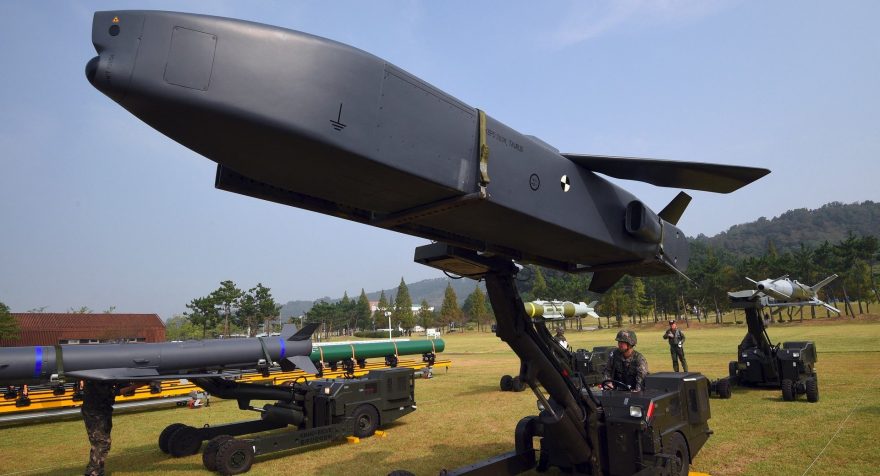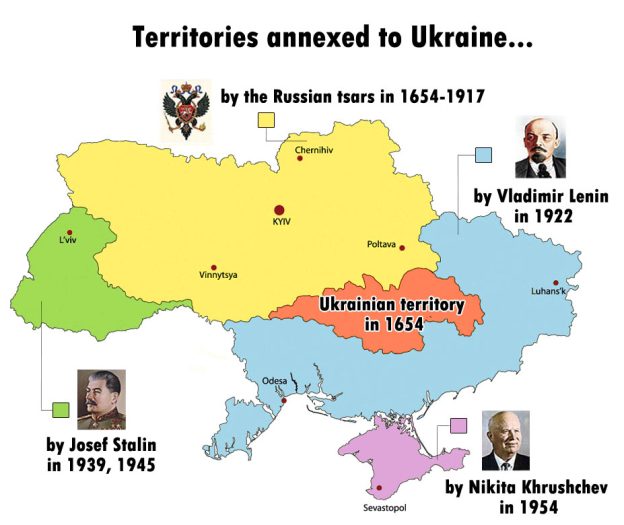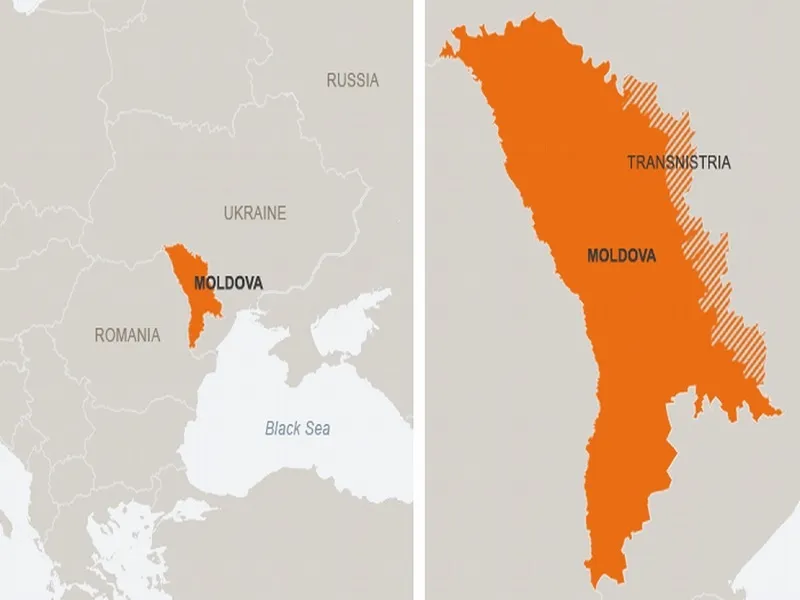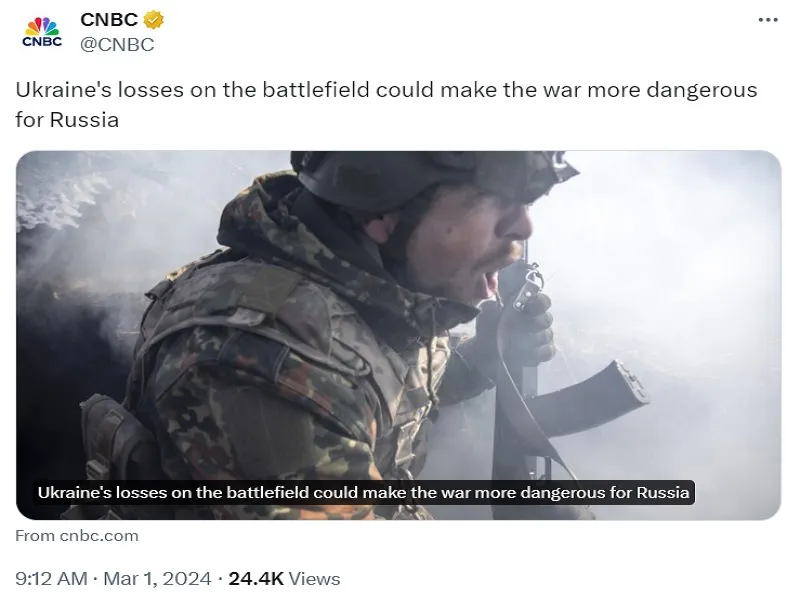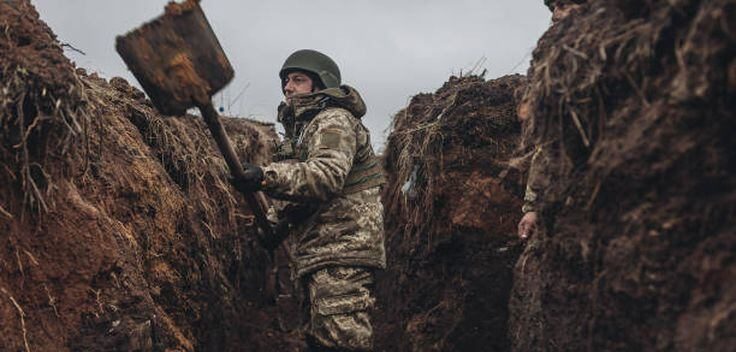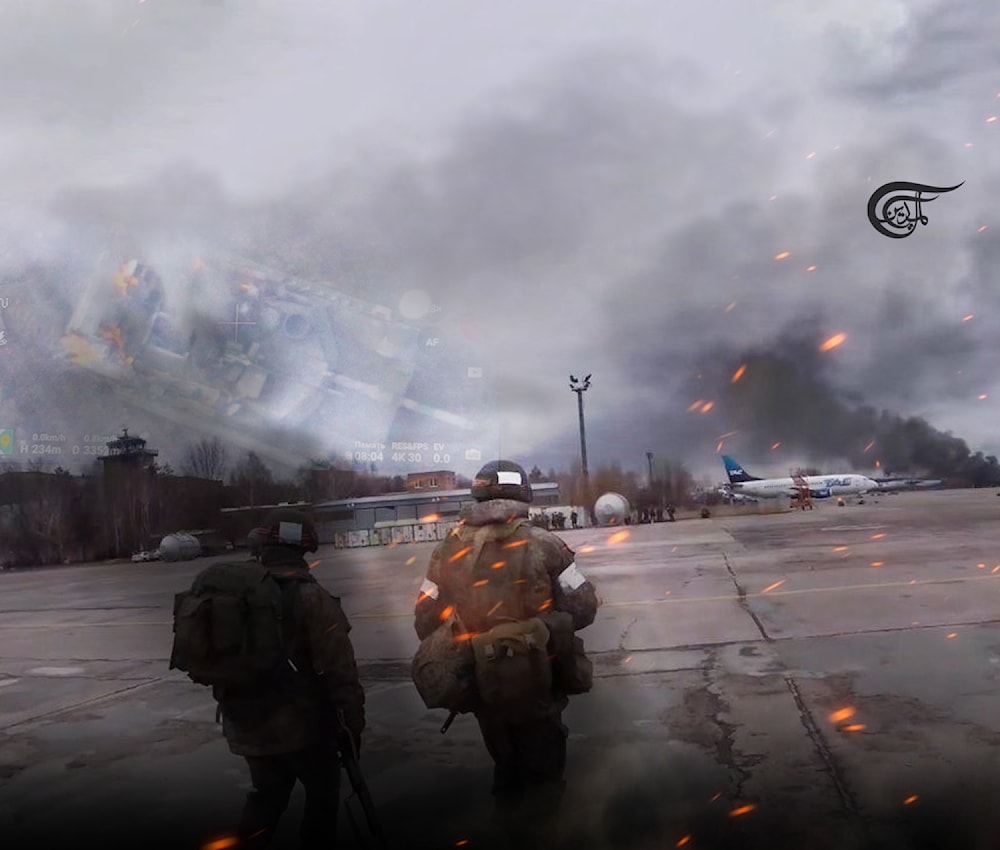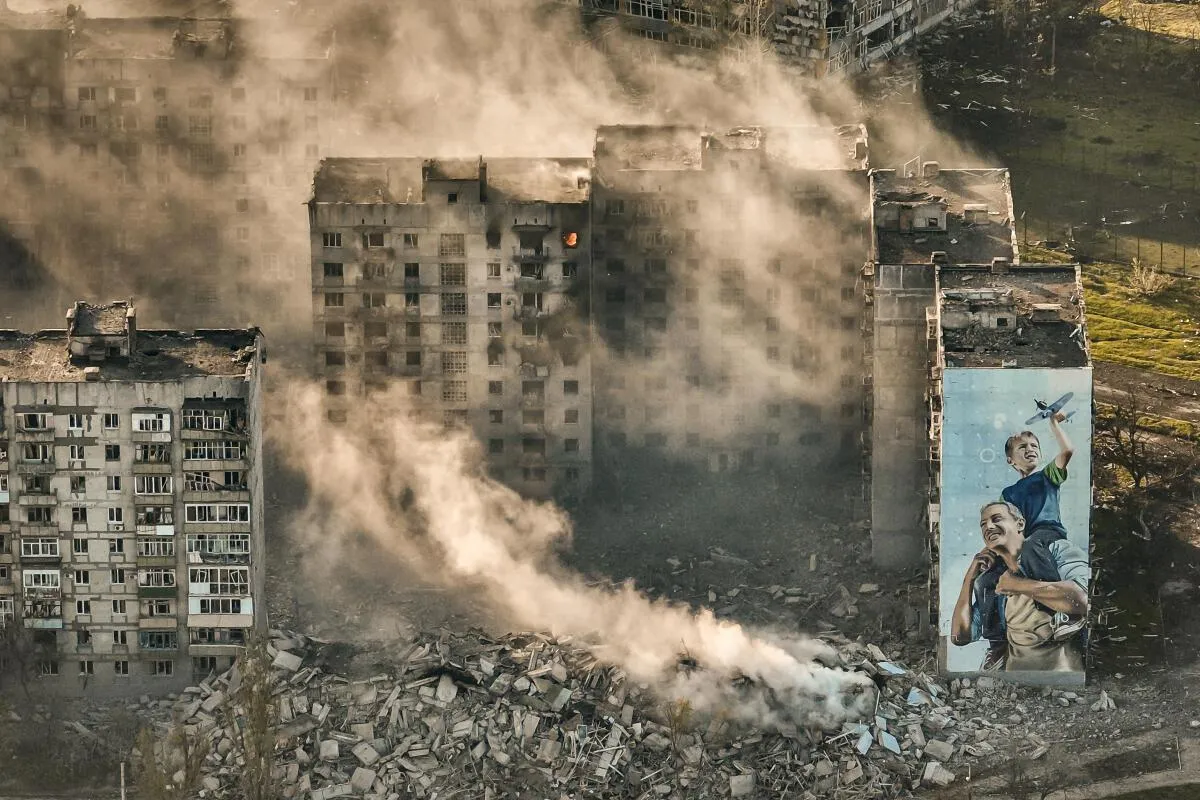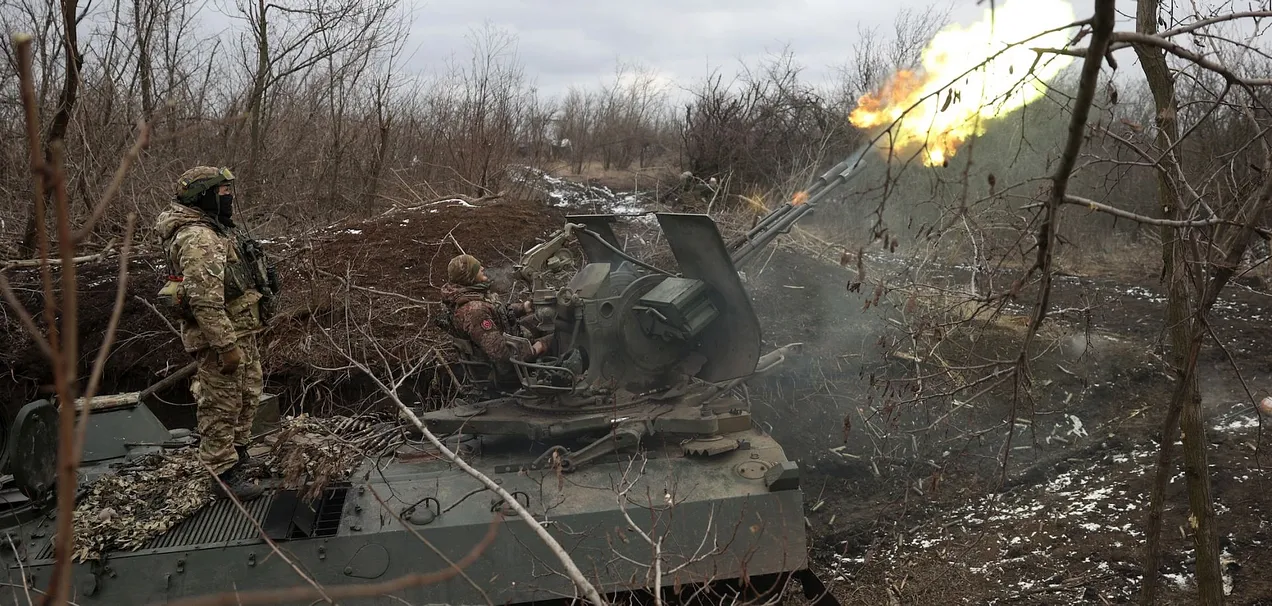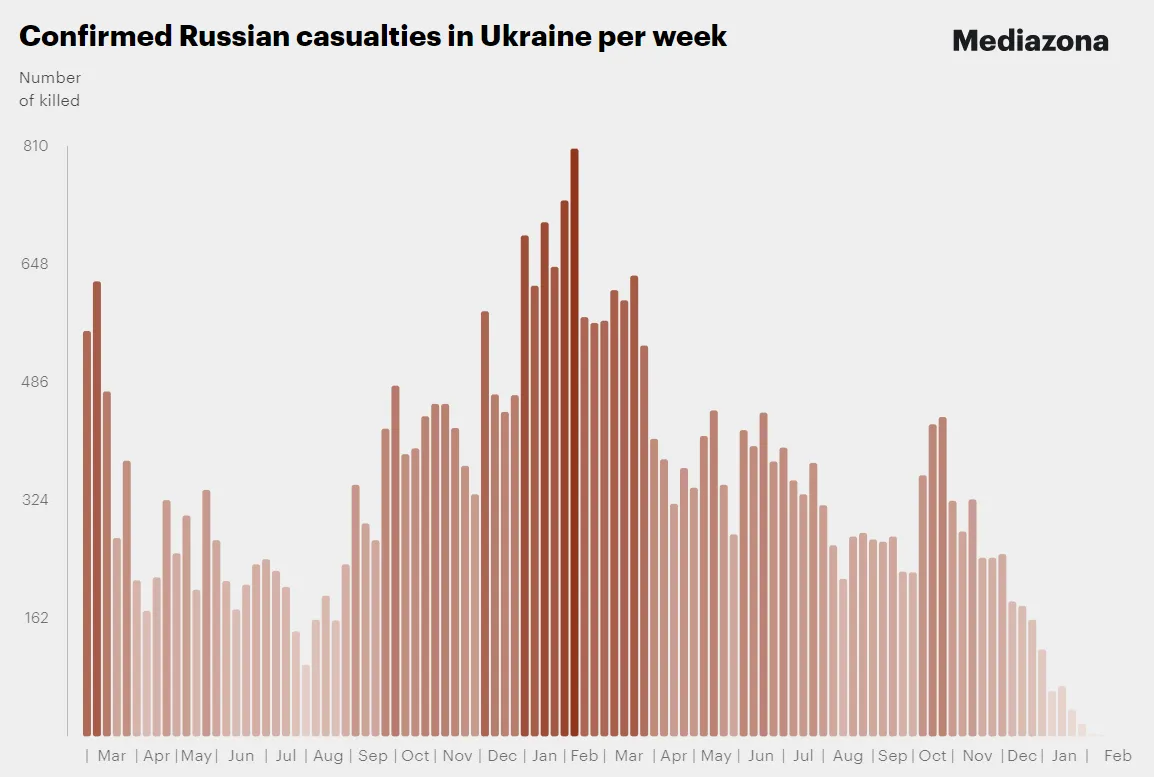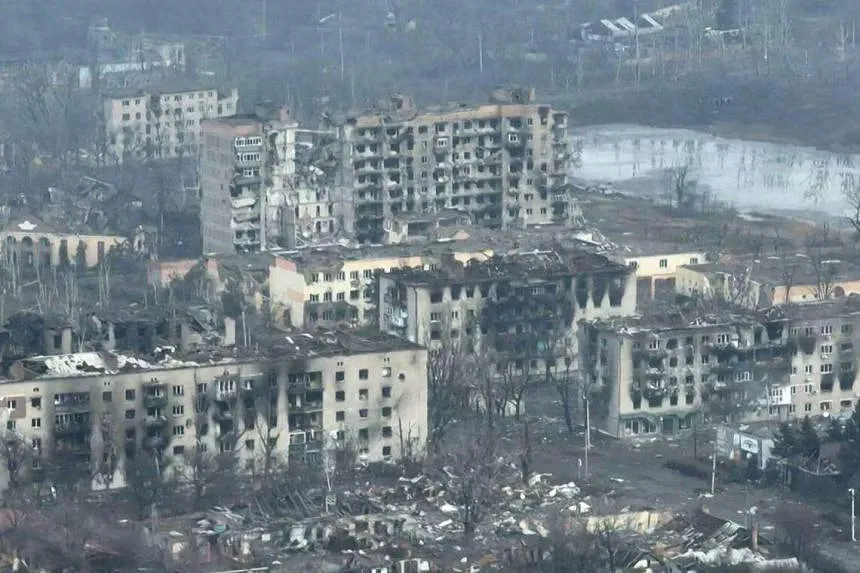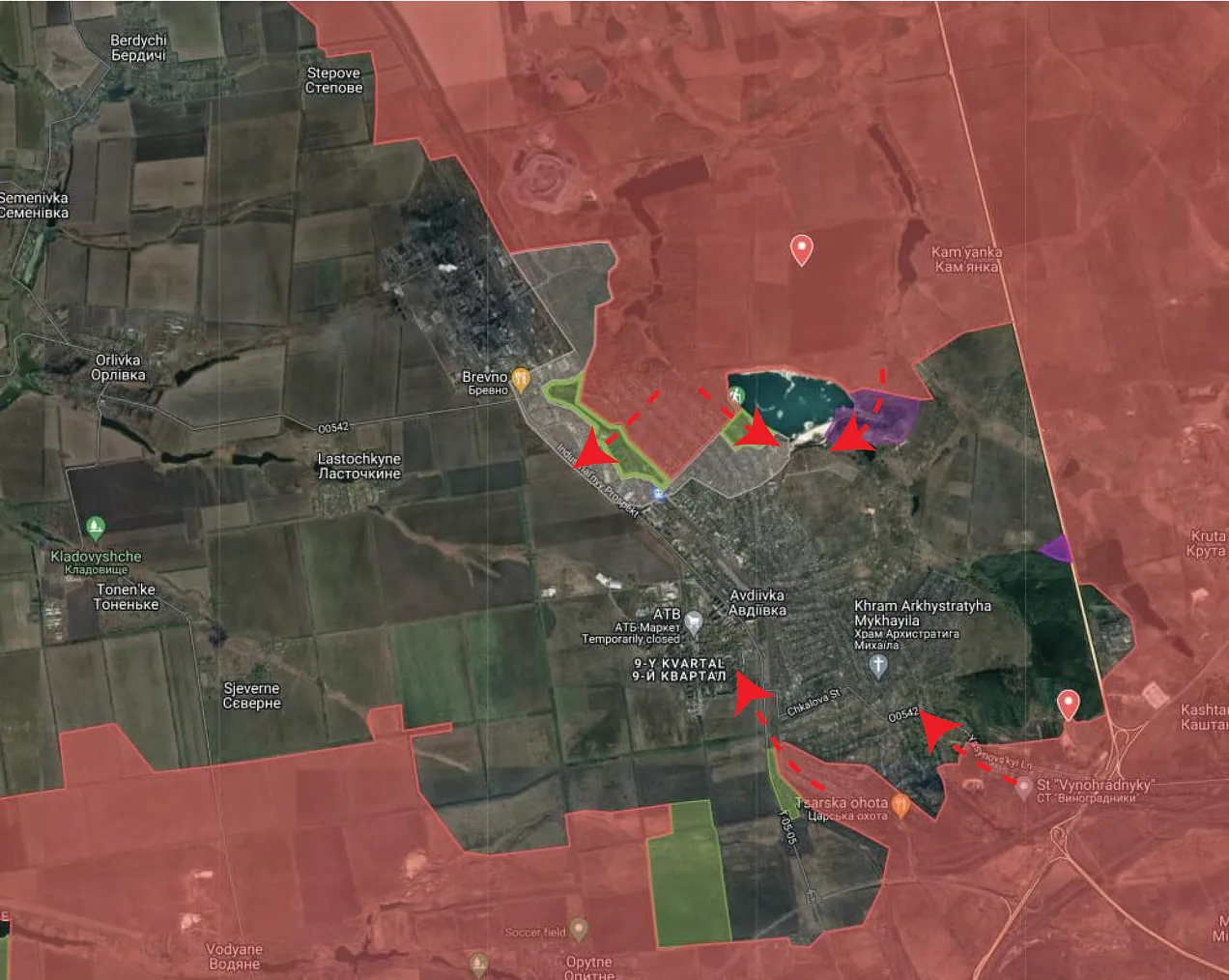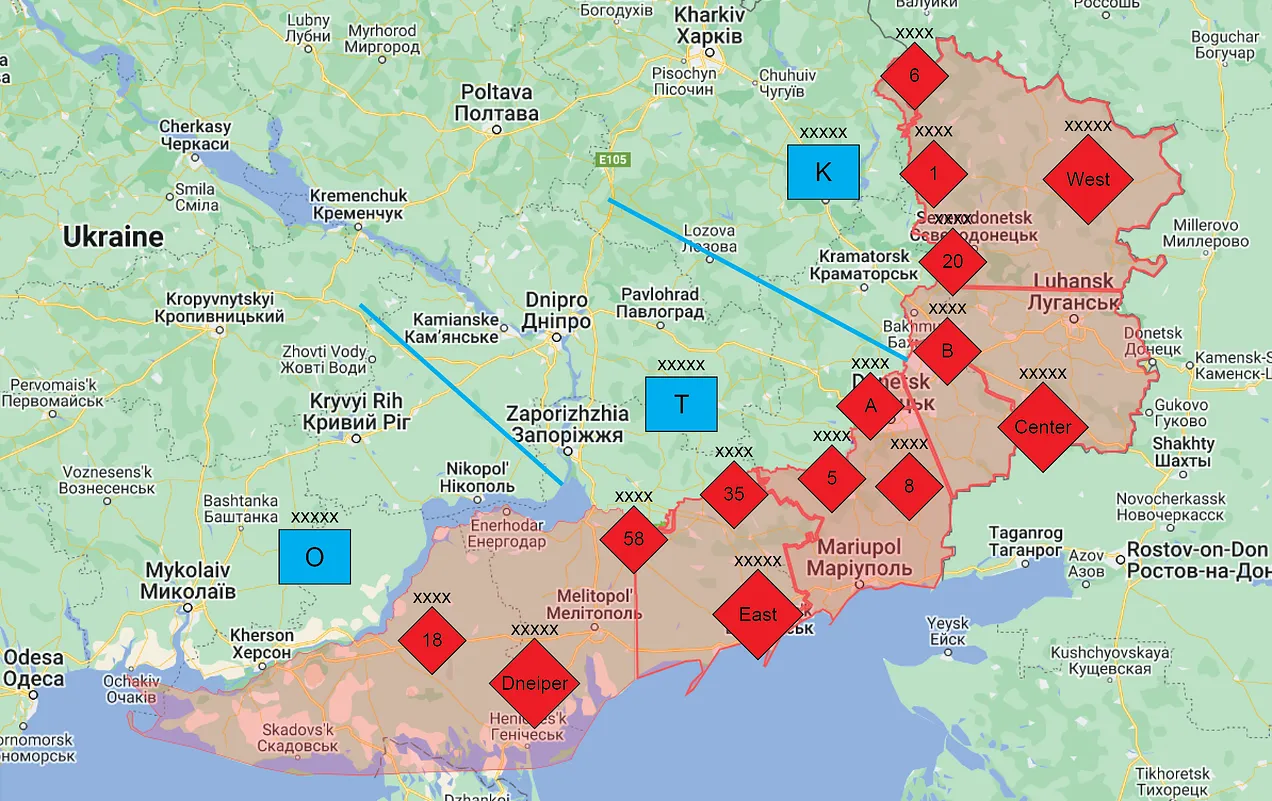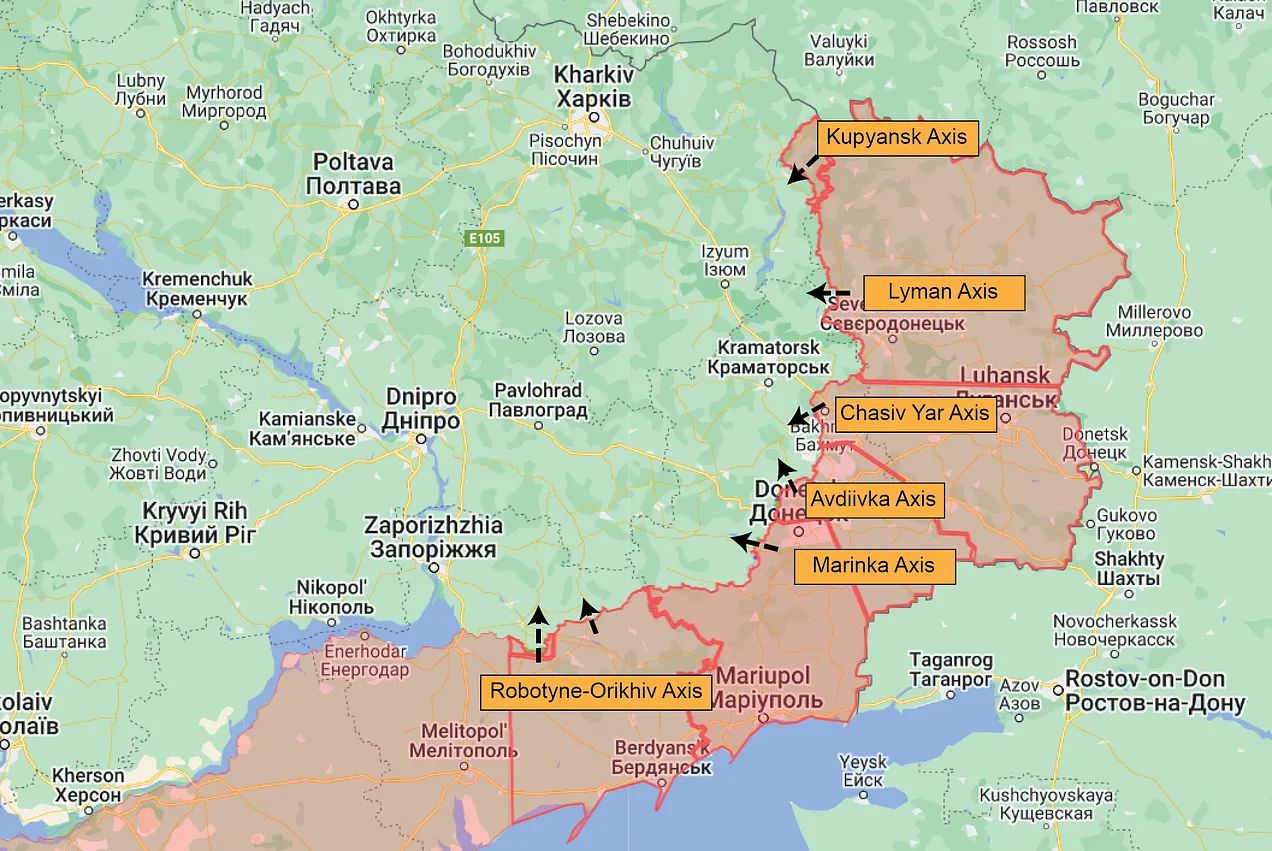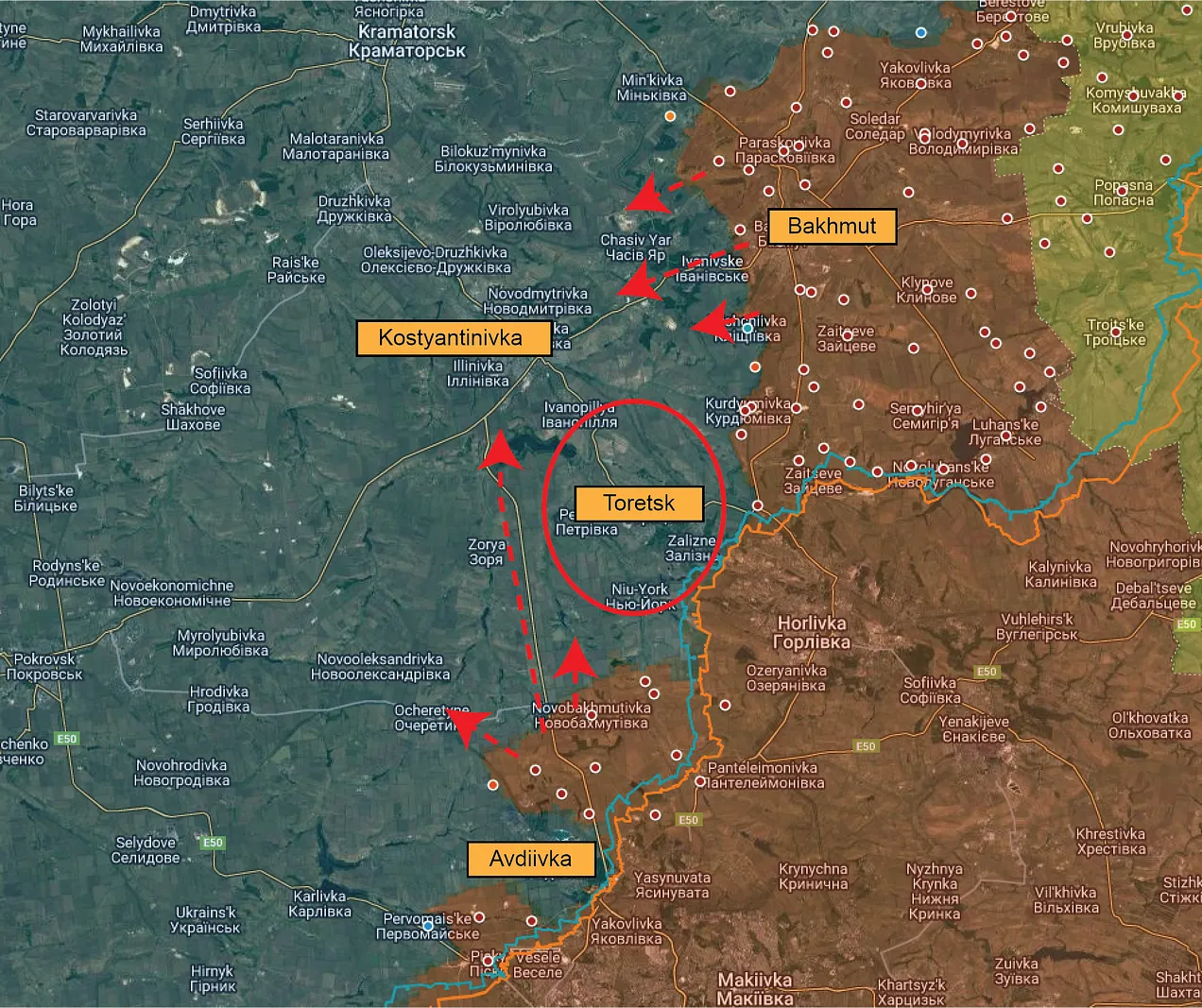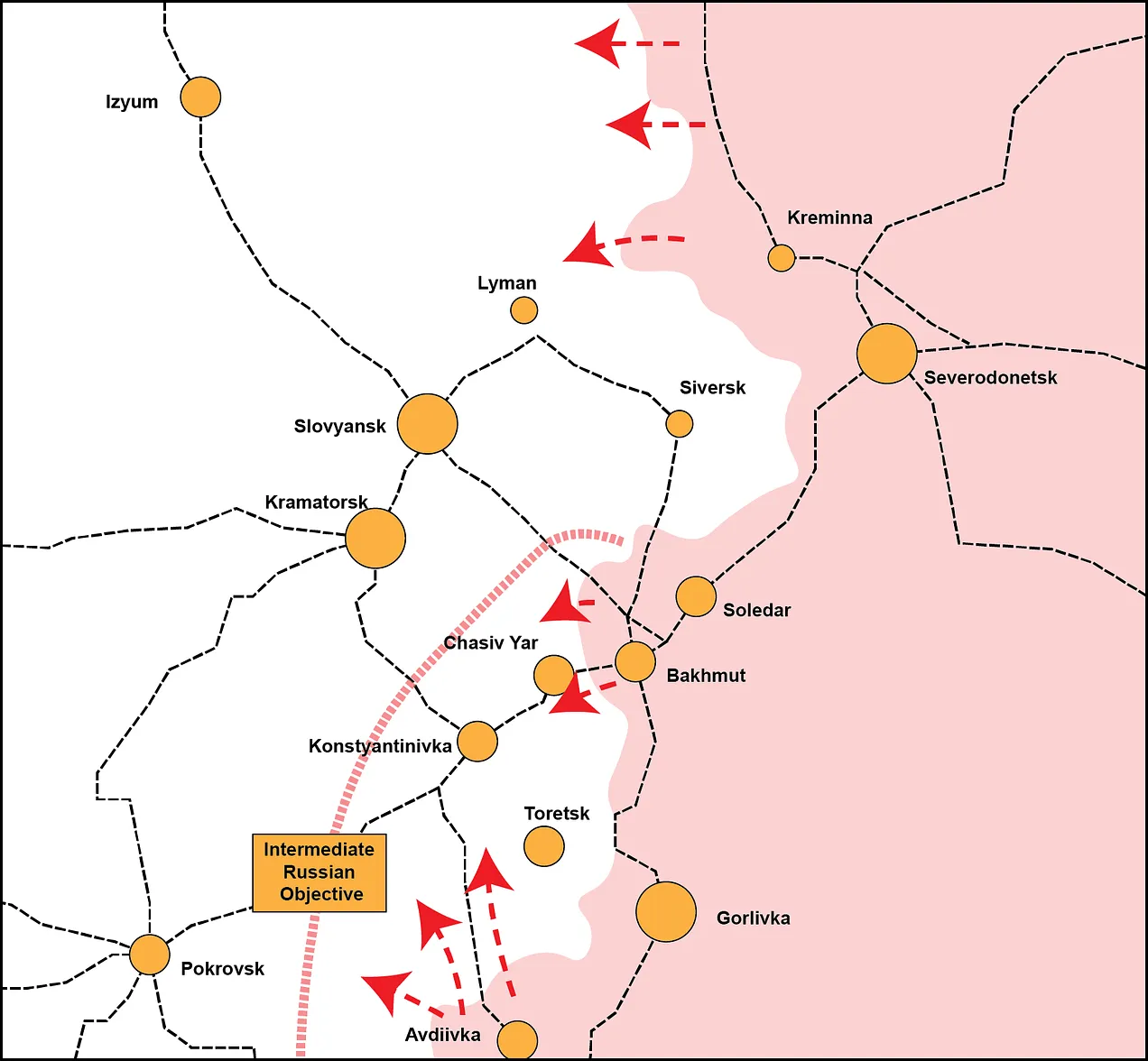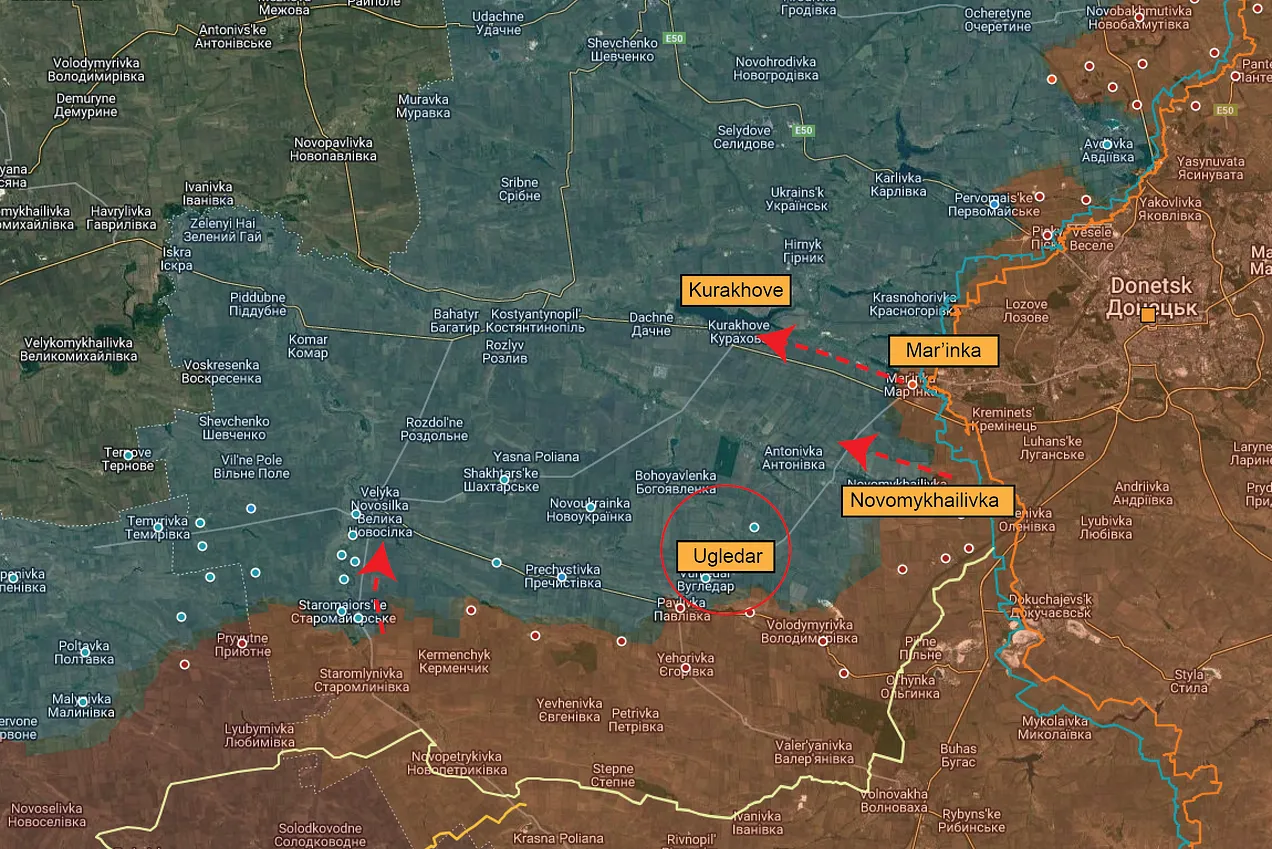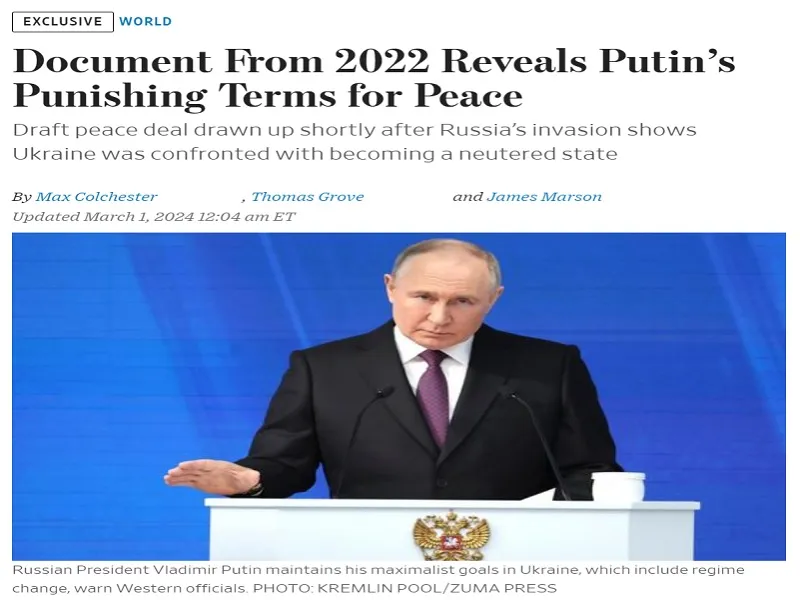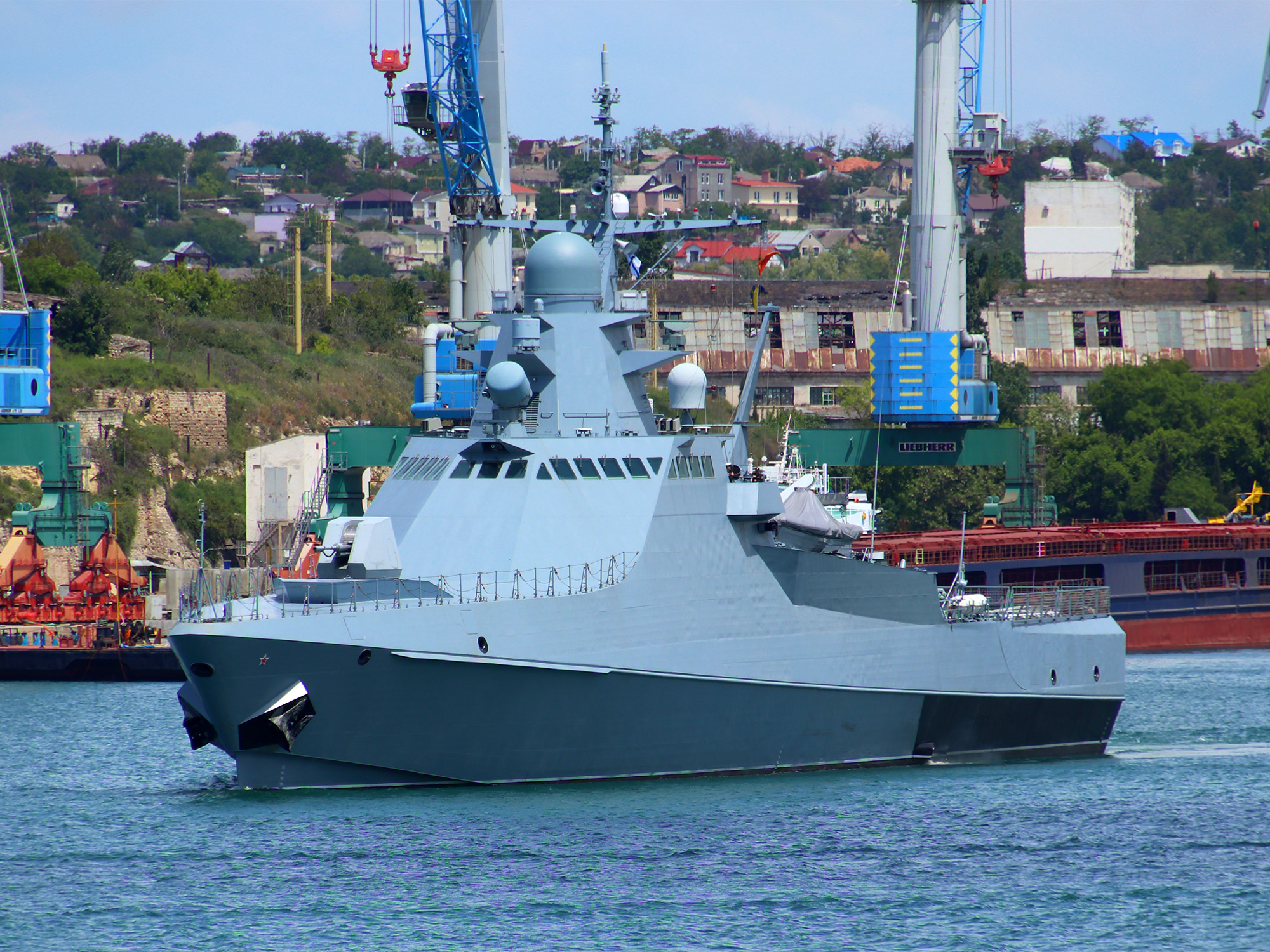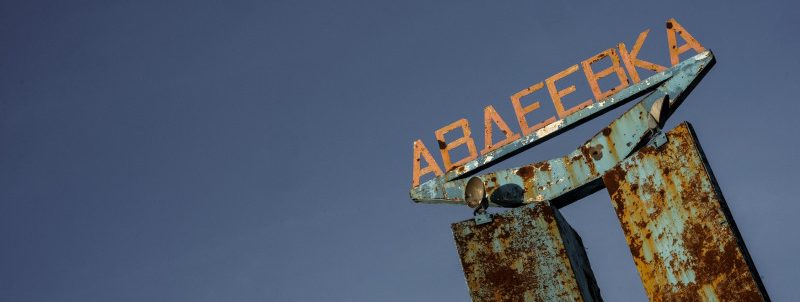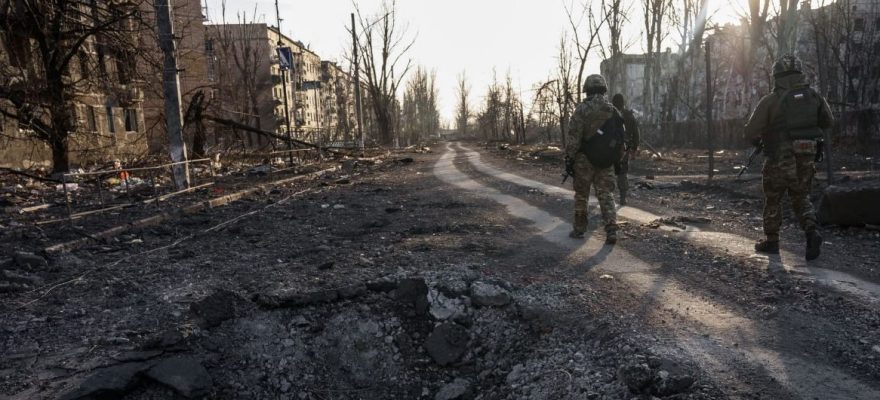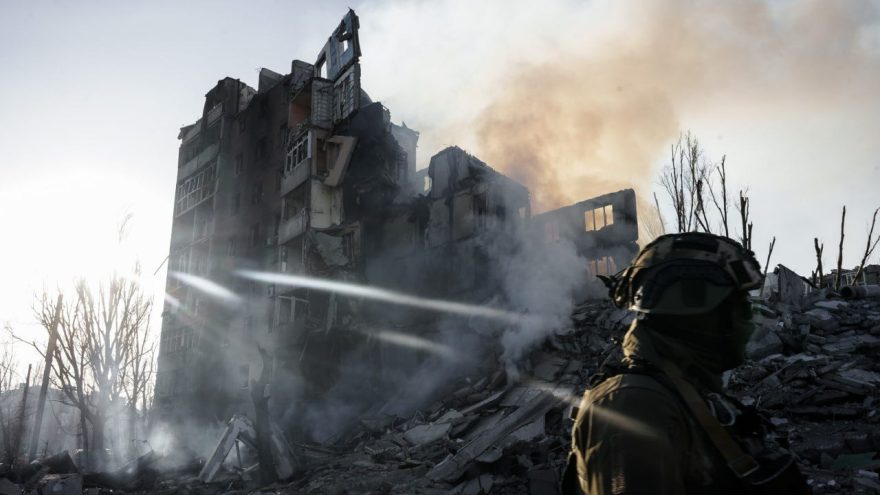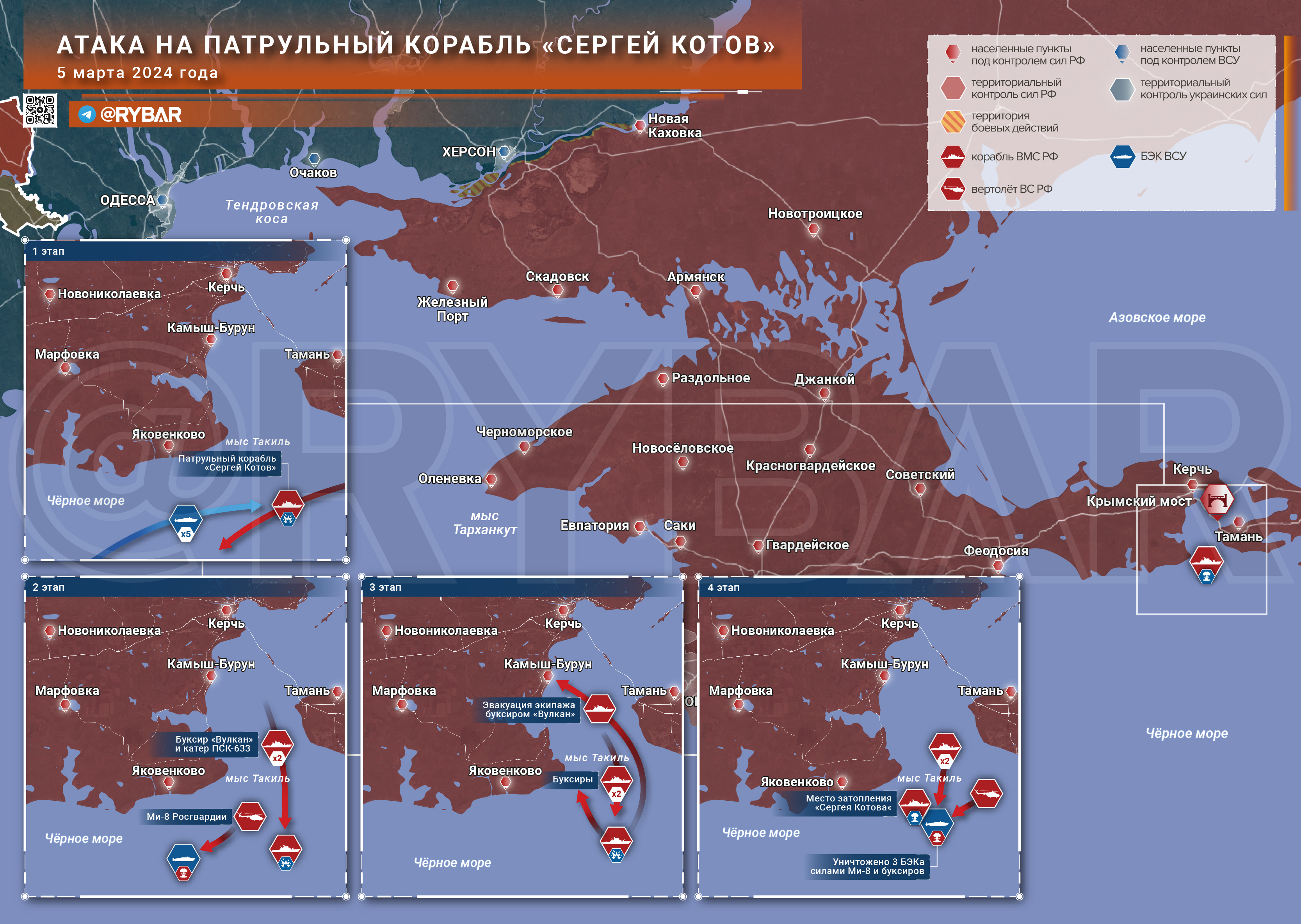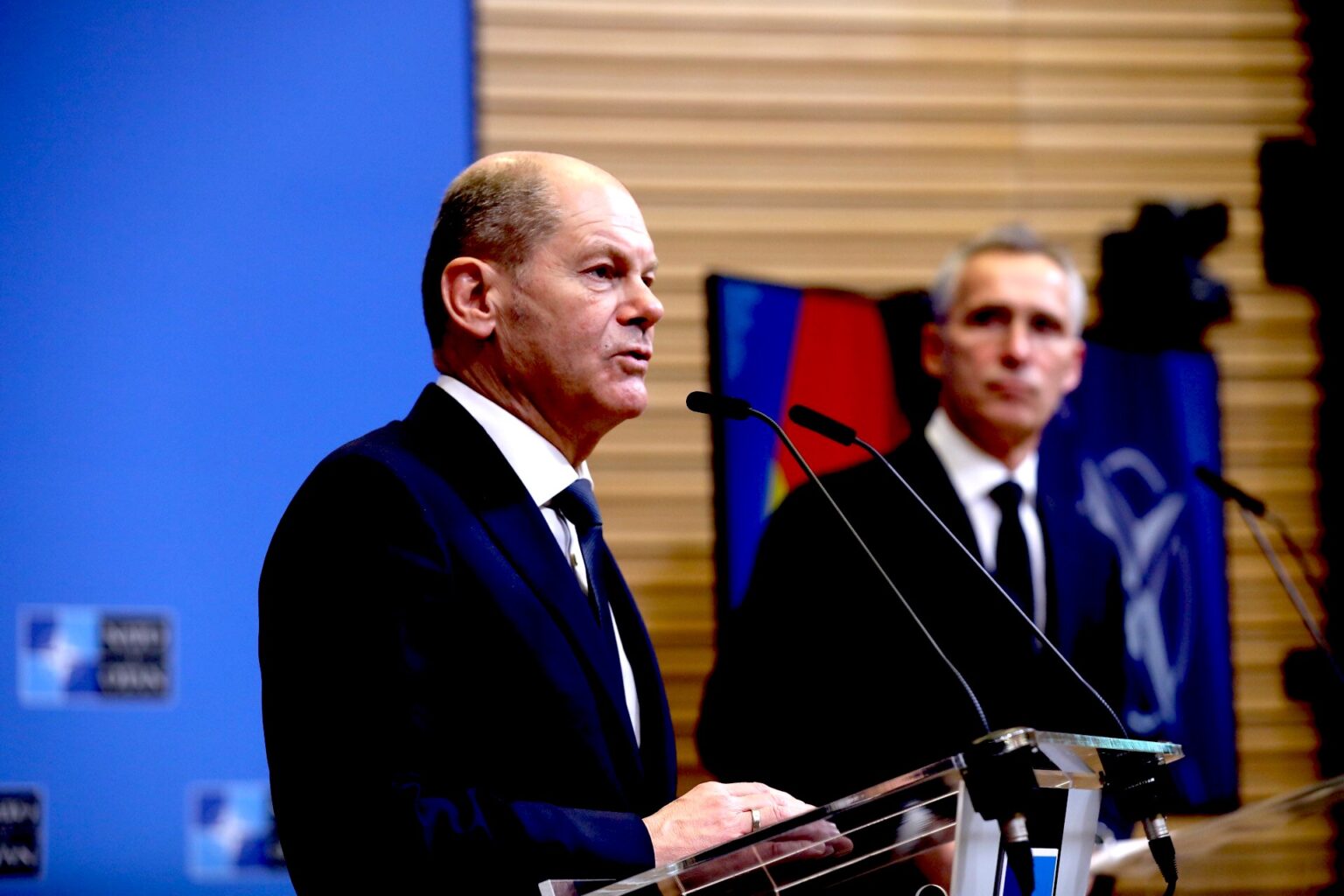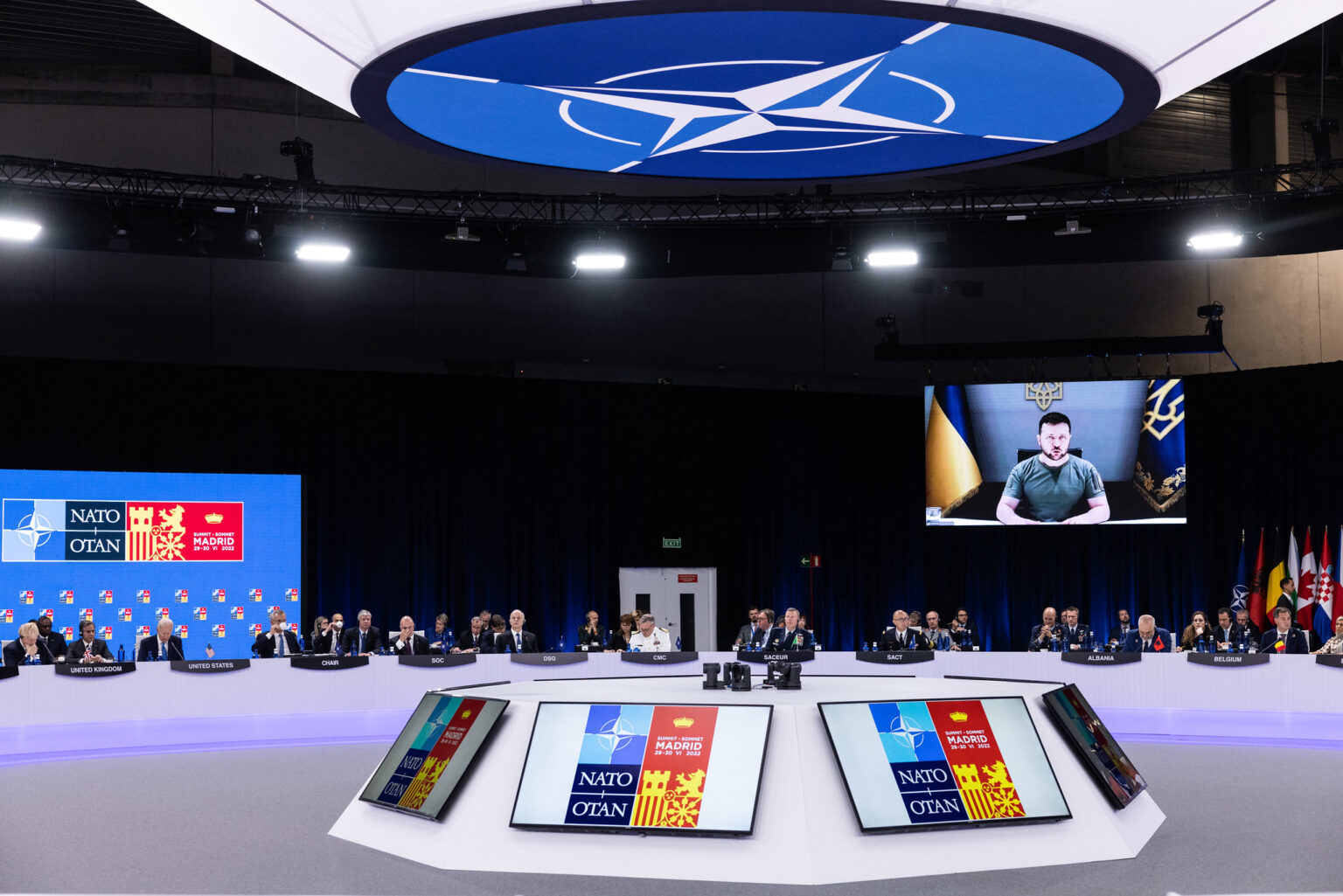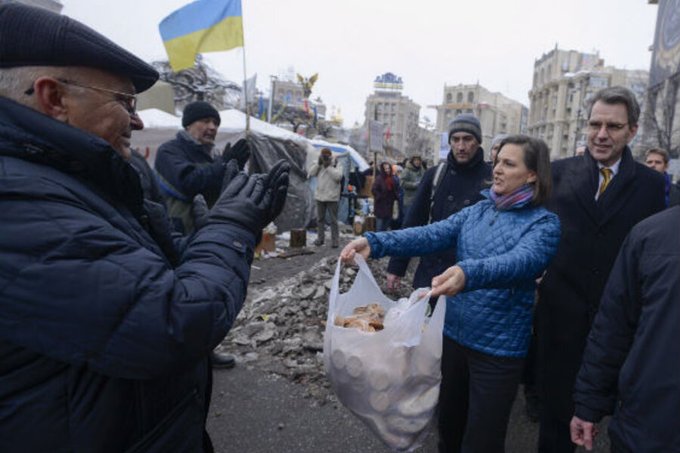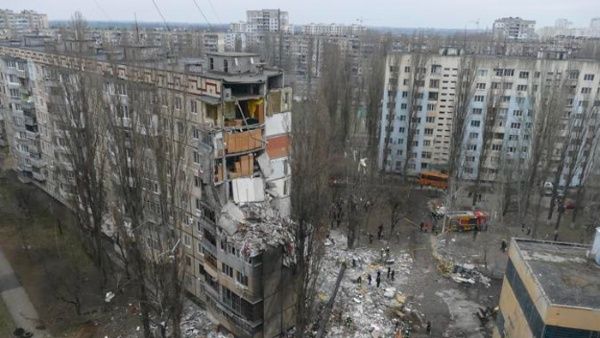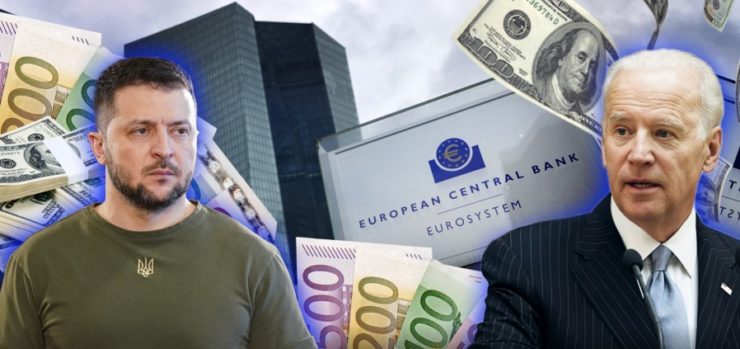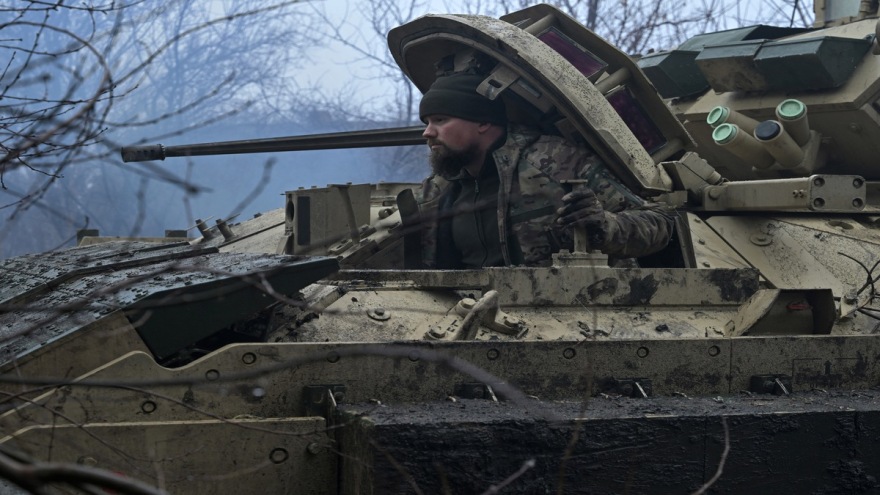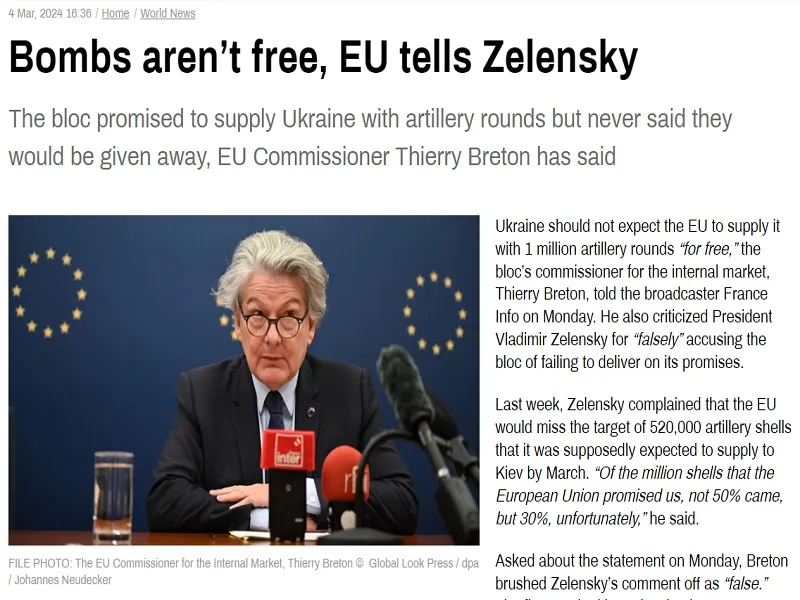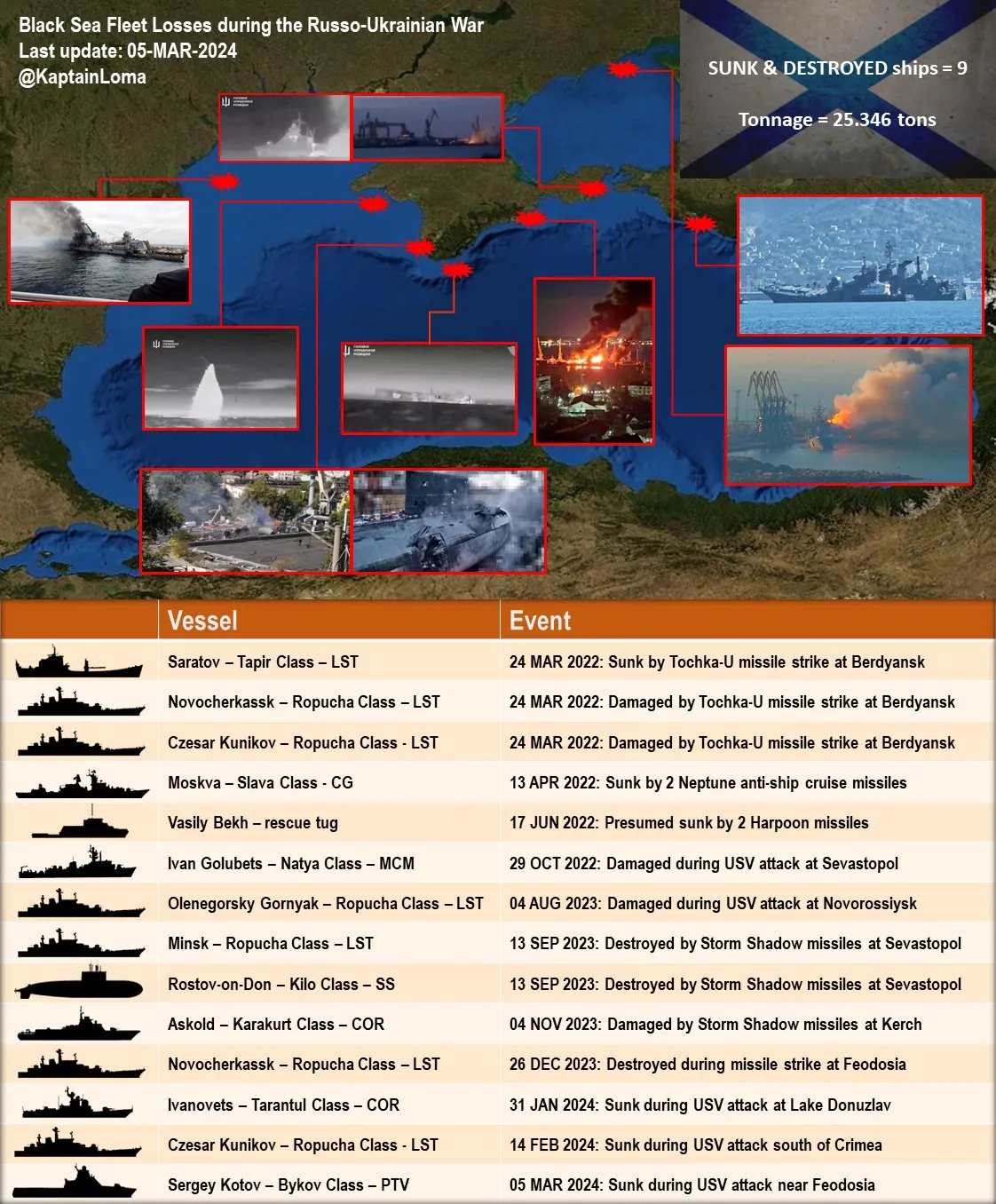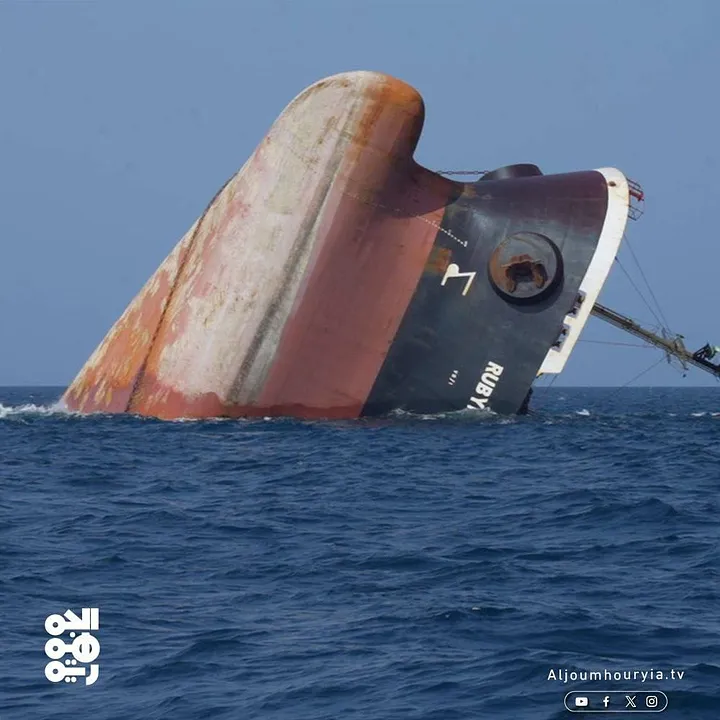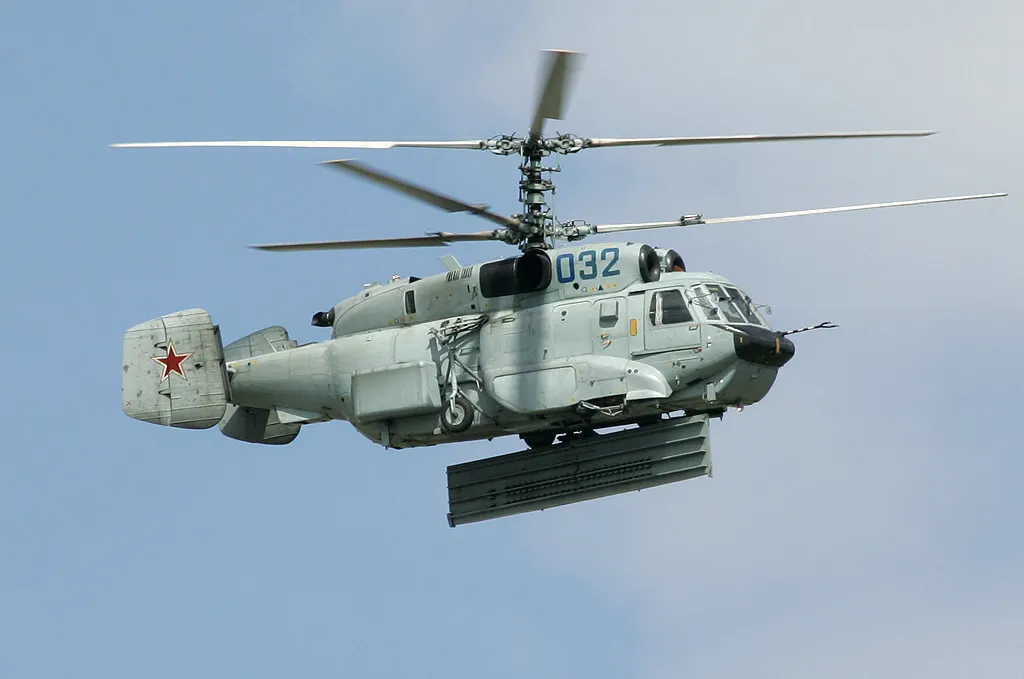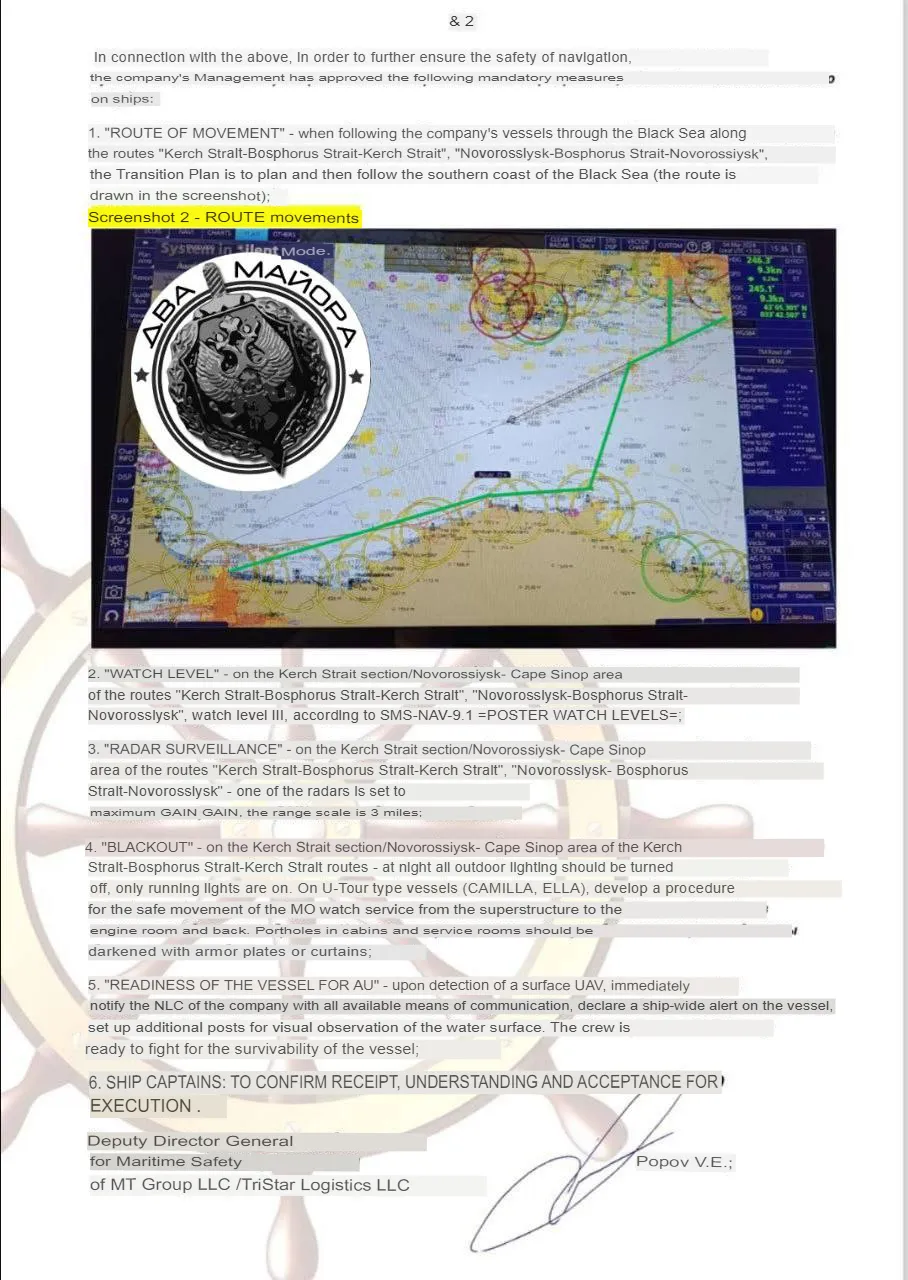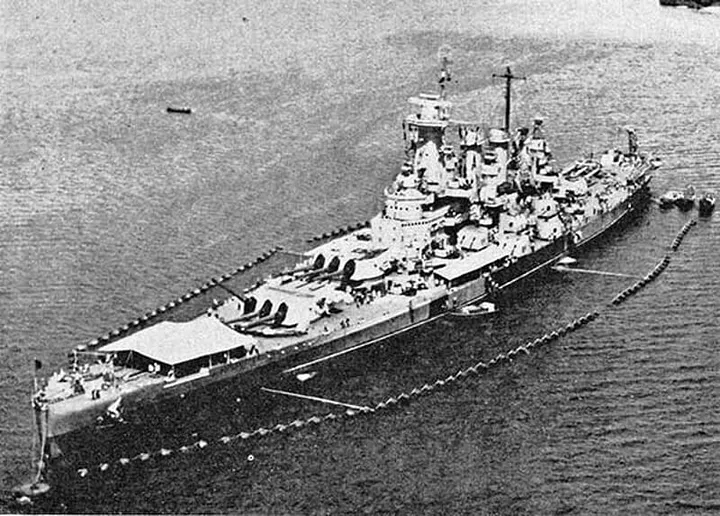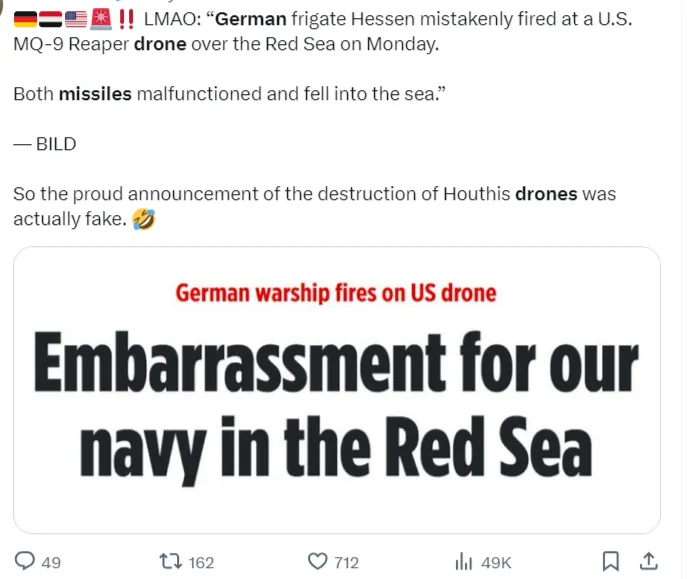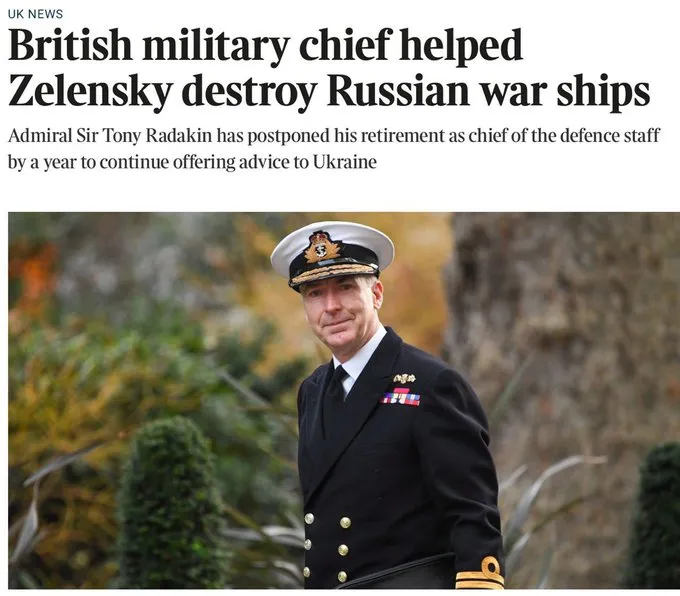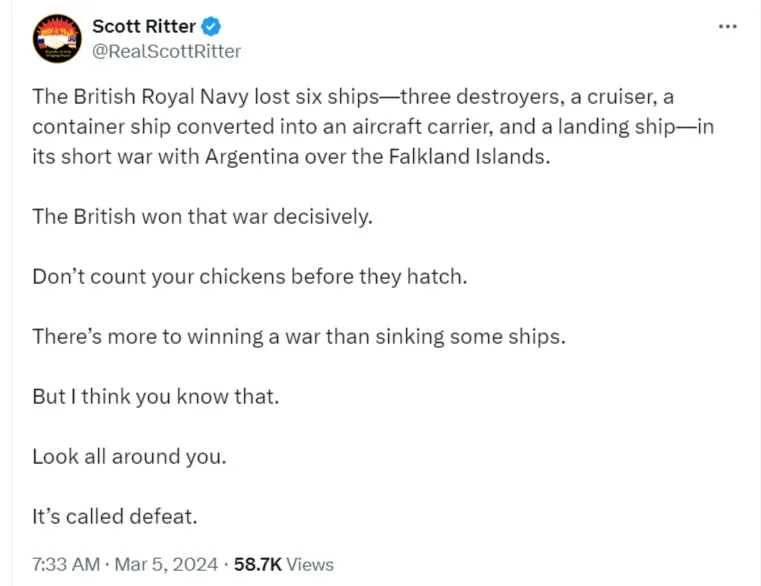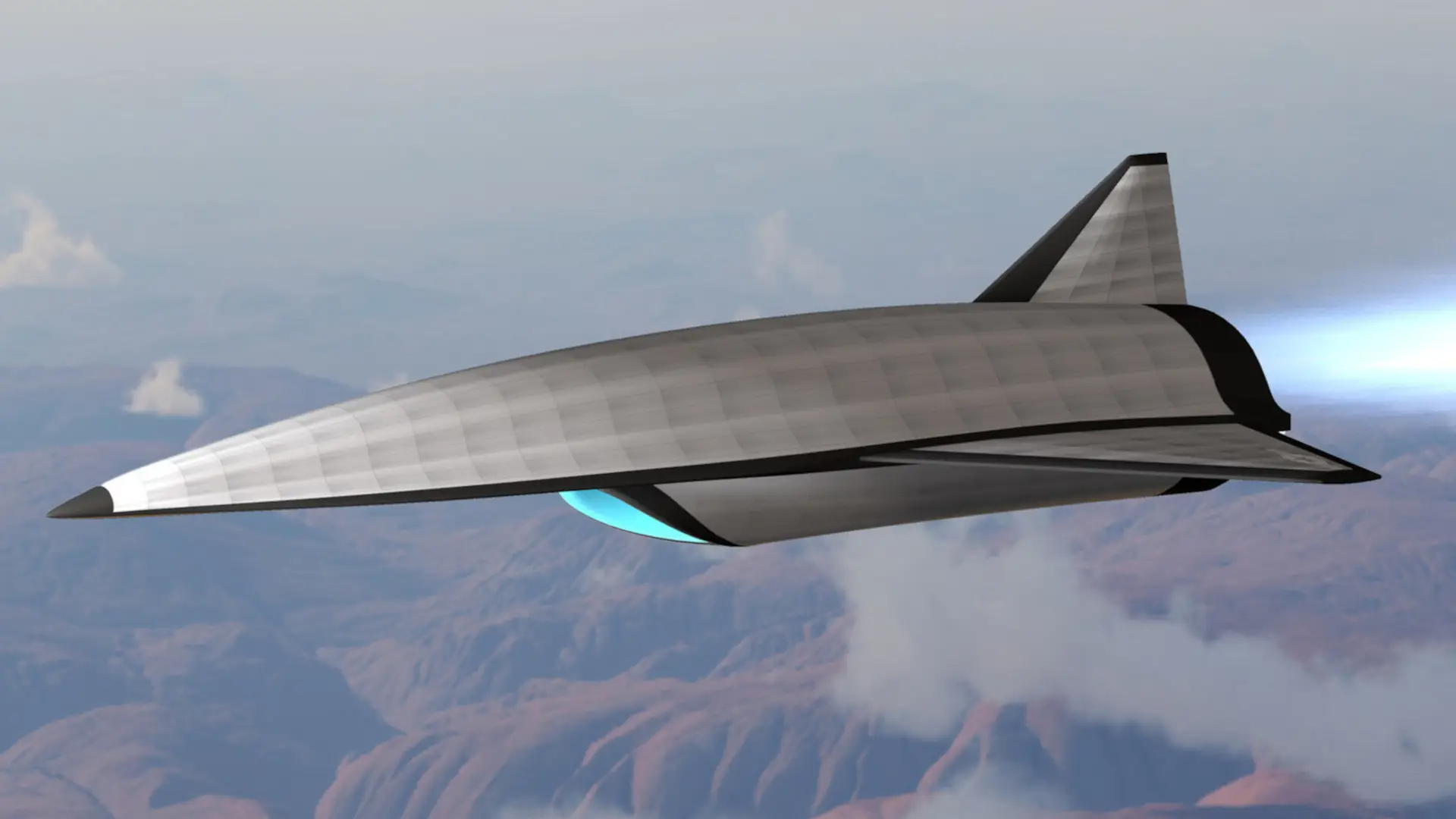 SIMPLICIUS THE THINKER
SIMPLICIUS THE THINKERMAR 1, 2024
A bombshell wiretap leak has set the intelligence and geopolitical world ablaze today, revealing high ranking members of the German Bundeswehr openly discussing plans to supply the Taurus missiles and help Ukraine destroy Russia’s Kerch Bridge.
Many are understandably pinning the leak on Russia’s GRU, but it seems just as—if not more—plausible that it was leaked by German insiders themselves in order to thwart the plans of their own deepstate establishment which is clearly bent on starting WWIII.
Before anyone questions the authenticity, let us first begin with the validation by Der Spiegel, who rules it as most likely legit:
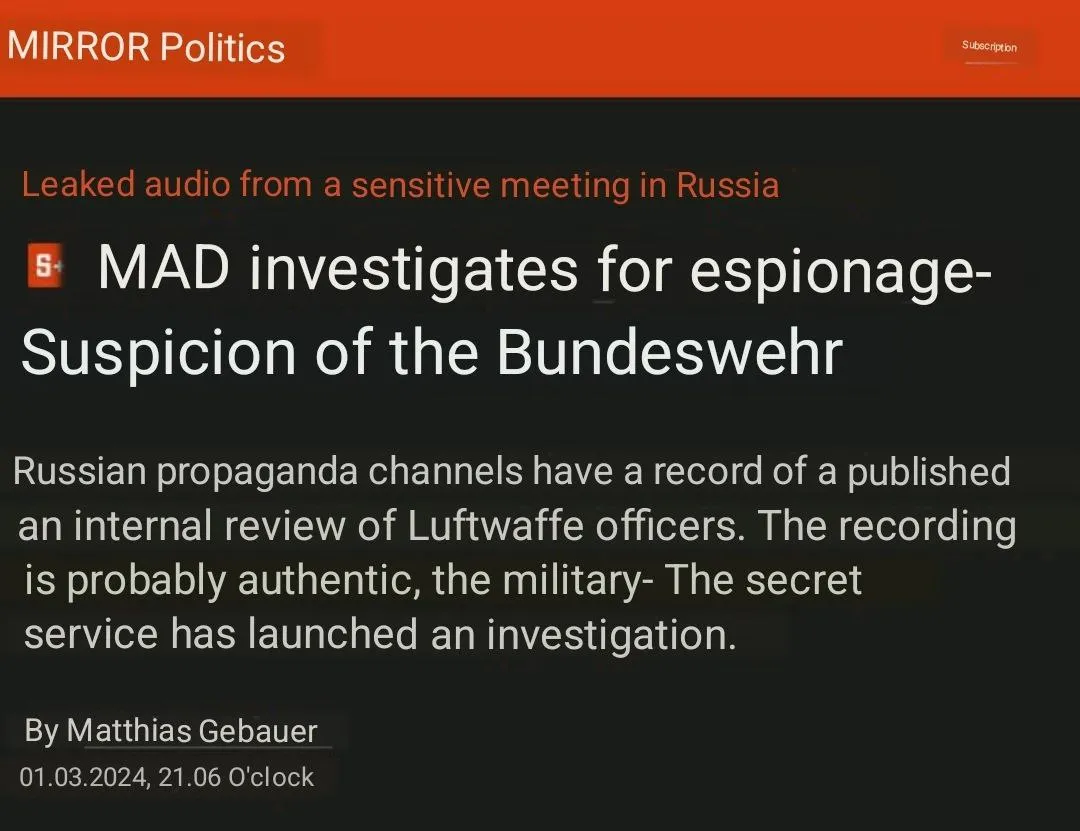
Spiegel writes about the authenticity of the audio recording of German officers discussing the attack on the Crimean Bridge.
"After initial analysis, it is presumed that the recording of the meeting is authentic. According to the initial assessment, the possibility of forgery using AI is largely ruled out," the publication reports.
Here are the most damning snippets: (Audio recordings at link.)
As well as another interesting couple: (Audio recordings at link.)
Here is the full recording for those interested—though, caveat, it’s an auto-machine translation and may have irregularities:
And here is a transcript of it provided by RT’s Margarita Simonyan, for those who prefer reading—though you’ll have to do a machine translation in your browser:
https://vk.com/@m_s_simonyan-rasshifrov ... -bundesver
It’s clear that there is an ongoing internal revolt in Europe by the last remaining sane faction against the hardliners pushing WWIII. This is evident by the fact that this entire pressure wave of ‘leaks’ suddenly coincided together from a variety of directions, which included Scholz himself outing British involvement in the war:
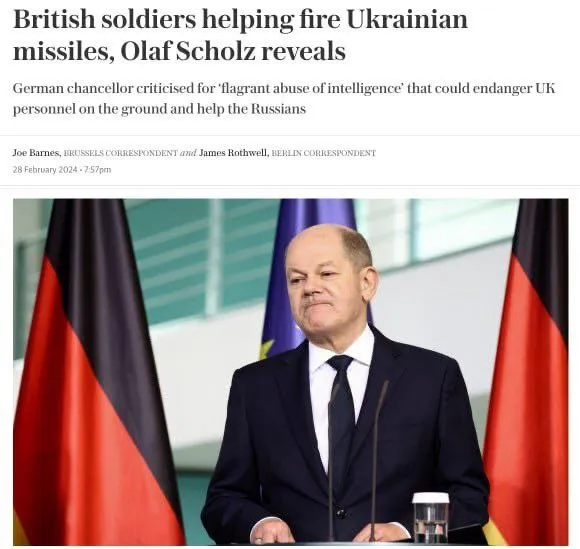
https://archive.is/BxskM
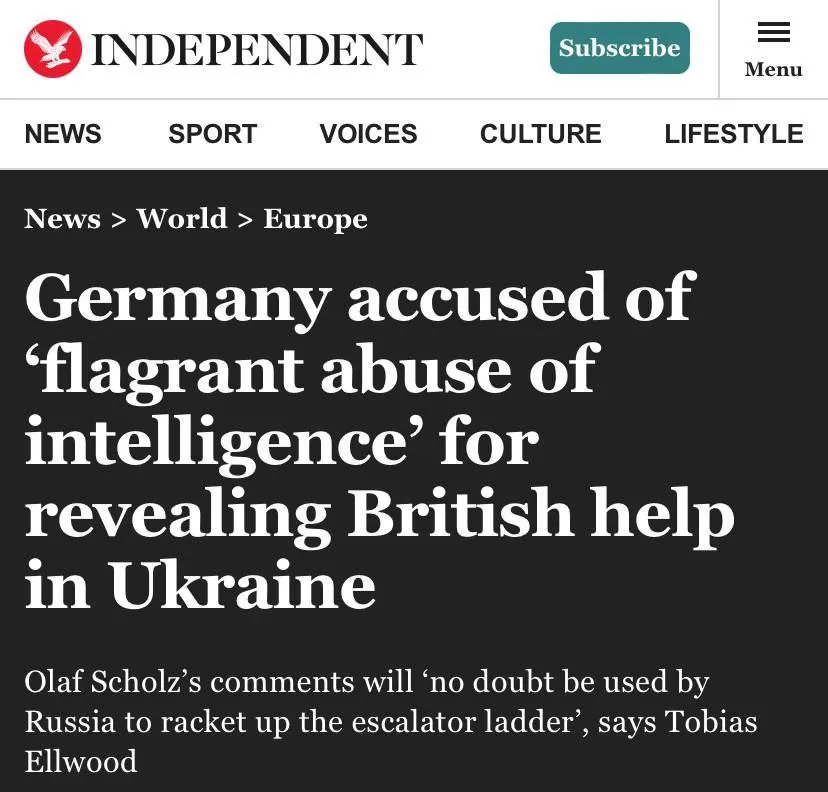
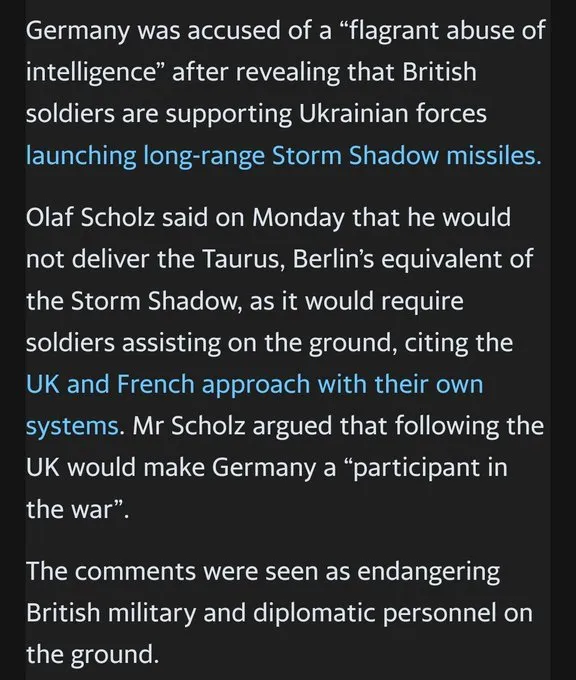
In light of Scholz’s disclosures, a slew of revelations have come to light about NATO’s true involvement in the war:

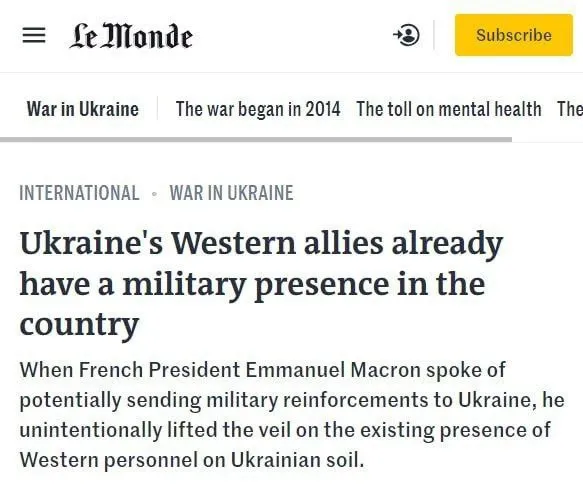
https://www.lemonde.fr/en/international ... 440_4.html
But what’s more, according to the Le Monde article above—though it’s behind a paywall—France is considering sending a contingent of special forces to Ukraine specifically to create a “strategic dilemma” for Russia:

https://www.rt.com/russia/593564-france ... ine-media/
The French government allegedly views such a troop deployment as a way of posing a “strategic dilemma” for Moscow, the paper said, adding that it could “constrain” Russia’s targeting and strike capabilities. In particular, it may prove to be “essential” ahead of the arrival of US-made F-16 fighter jets, scheduled to take place later this year, the French daily added.
Keep in mind, ostensibly, they’re referring to a small contingent of troops placed somewhere in the rear to ‘train’ Ukrainian soldiers. But the ‘strategic dilemma’ part is very interesting—what could they possibly mean by that?
The article makes some interesting revelations. For instance, it seems to suggest that the timed release of all the current hints is a precisely choreographed CIA campaign meant specifically to give signals to Moscow:
US intelligence services's controlled transparency operation – known as "campaigning" – is part of their plan to reinforce a form of strategic ambiguity that was initiated by Monday's meeting of allies in Paris, several sources close to the matter told Le Monde. Although the US was not involved in the precise wording of what Macron was going to say and may have been surprised by his remarks, the prospect of sending Western troops to Ukraine had been talked about in advance. The US had also sent a representative to Paris. The growing pressure from Moscow on Europe's eastern flank is worrying the US as much as the other participants.
On the aspect of ‘strategic dilemma’ they note specifically:

But here is the final and most important paragraph of the entire article, which ties directly into things I’ve been writing about and predicting here from the very beginning:
Paris wants to provide Kyiv training in surface-to-air defense in particular, which has been targeted by the Russians. The presence of French soldiers, or those of other nationalities, would potentially secure certain areas of Ukrainian territory and severely restrict Moscow's current unfettered bombing. An allied presence would also prove essential to the promised arrival of American-built F-16s in Ukraine in 2024.
And that, folks, is what gives the true game away.
Recall my earliest predictions about NATO coming in to ‘secure’ certain critical areas of West Ukraine from Russian takeover at the final hour when all else fails and it seems certain that Russia will overrun the AFU. I spoke specifically about Odessa, with the 101st and 82nd coming to dogpile and squat on it simply in the hopes that Russia will cautiously refuse to send troops, in fear of ‘clashing’ with NATO forces and starting WWIII.
It seems the French have got the same idea, though it may be for a different area or areas—hoping that by simply placing troops there, Russia will hesitate from striking the critical infrastructure for fear of killing NATO soldiers.
Interestingly, however, soon after French Foreign Minister Stephane Sejourne rejected this possibility:

https://www.rt.com/news/593559-no-comba ... ne-france/
No combat troops will be sent to Ukraine, French Foreign Minister Stephane Sejourne told Radio France Inter on Friday. Earlier, the nation’s president Emmanuel Macron told journalists that NATO could entertain such a possibility in the future.
Paris would not risk a direct conflict between Moscow and the US-led bloc, Sejourne said when asked to comment on Macron’s remarks. “Everything we do is to avoid war” between Russia and NATO, the minister said, adding that the French government did not want to increase the level of anxiety among its citizens.
A new poll from Le Figaro likewise showed 68% of French citizens do not approve of troop deployment to Ukraine:
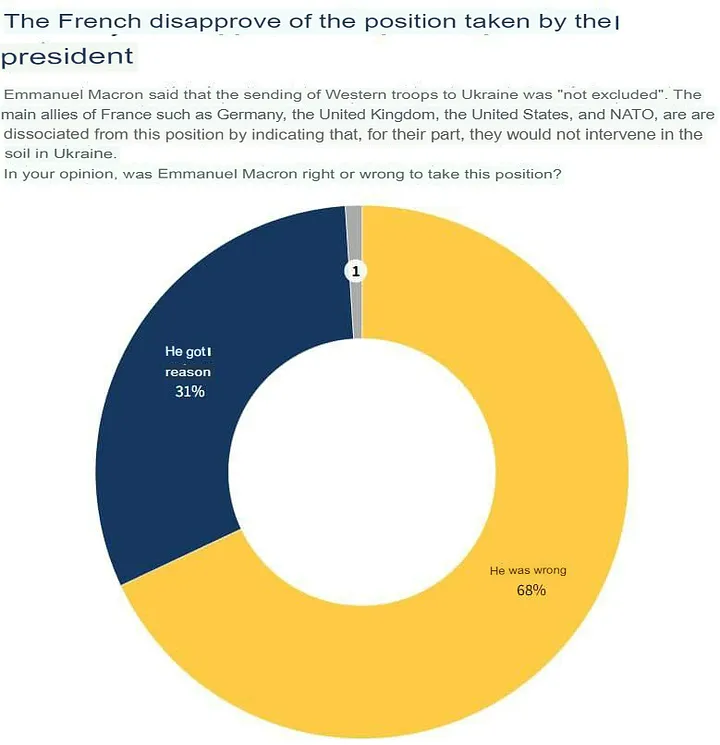
68 percent of French people do not approve of Emmanuel Macron's position on the possibility of introducing Western troops into Ukraine, 31 percent agree. This is according to a poll published by Le Figaro newspaper
However, on the heels of these bombshells, Canada attempted to join the fray:
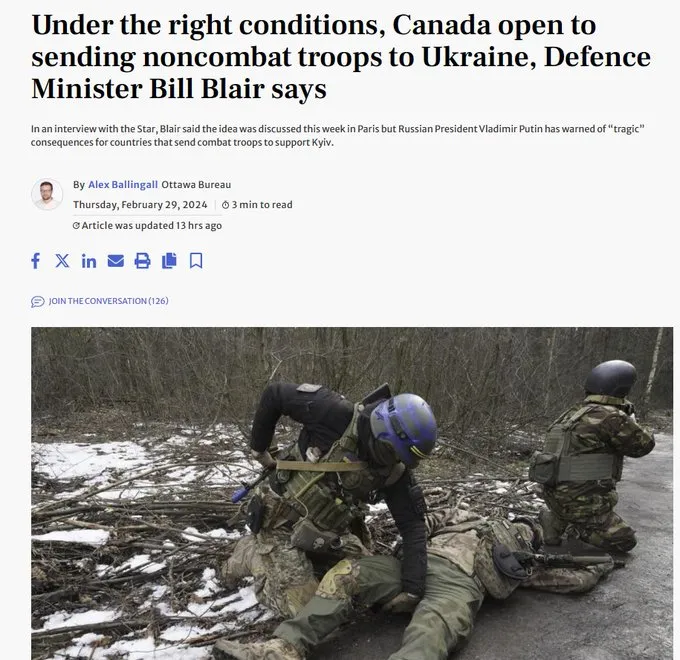
https://euromaidanpress.com/2024/02/29/ ... krainians/
The Canadian Minister of National Defense, Bill Blair stated today that Canada is willing to Participate in a NATO-Led Training Mission for Ukraine, which would involve the Deployment of a Limited Contingent of Canadian Servicemembers into Ukraine, who would assist in the Training of the Ukrainian Armed Forces and act in a Non-Combatant Role against Russia away from the Frontlines.
You can see the desperate, seeking attempts to find any lifeline for Ukraine. The NATO/EU nomenklatura are scrambling to create any possible conditions that may give Ukraine a tiny leg up, or even some leeway or breathing room for a few months.
In general, though, this recent spate of threatening announcements could simply be a message to Russia: in essence, a warning in attempt to get Russia to make concessions about resolving the conflict, or simply to keep it from pursuing the most maximalist goals.
This of course all stems from the urgency inherent to Russia’s growing battlefield initiative, where Russian forces continue breaking through Ukrainian lines, generating total trepidation across the Western globalist ruling class:
<snip>
For the last part, let’s move into some of the battlefield updates which are, after all, driving much of the frenetic urgency we’re seeing out of the West, which is responsible for the latest leak fiasco. If it wasn’t for Russia’s overwhelming battlefield successes, and Ukraine’s concomitant ongoing collapse, we wouldn’t see these drastic and risky measures taking place.
The only thing I want to cover today in this regard is the current ‘meta’ surrounding the Avdeevka line collapse. We’ve discussed how most of it is owed to Ukraine’s inability to build proper second echelon defenses on this axis, for a variety of reasons which include corruption and embezzlement.
From a Ukrainian source:
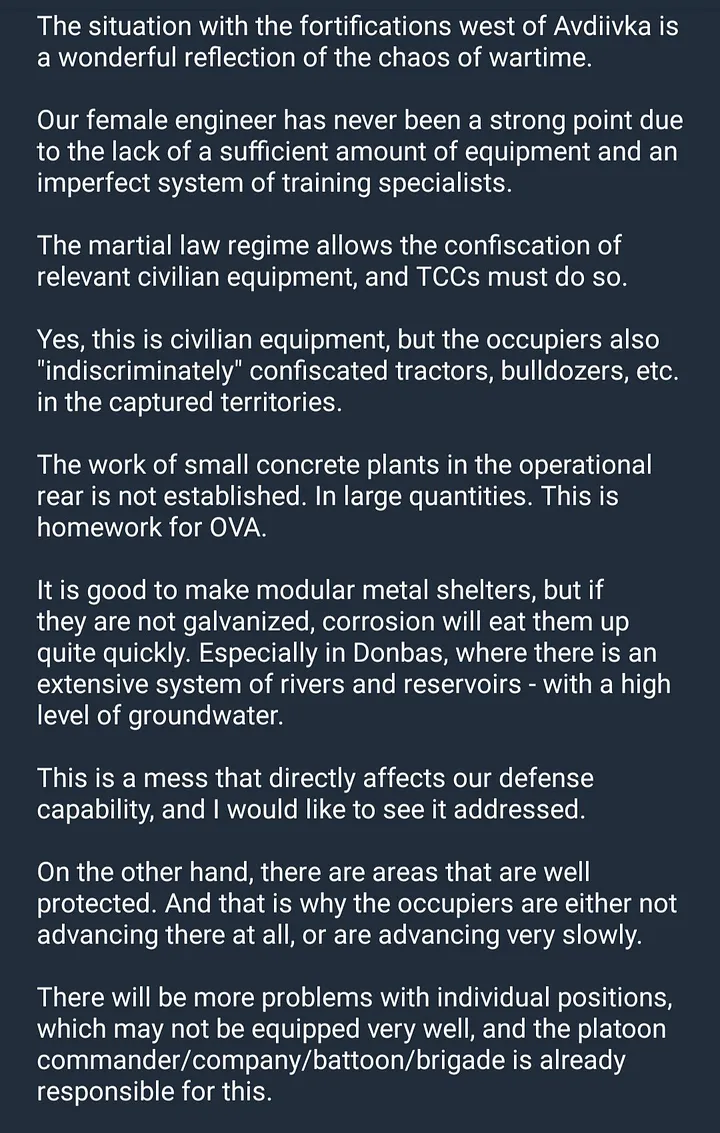
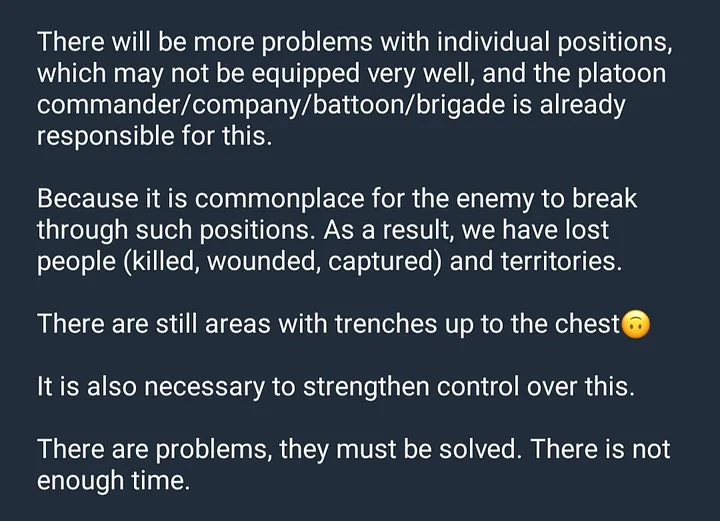
One notable aspect missing from much of the analysis here is the fact that Ukraine’s collapse was precipitated in large part to order-spurning mutinies, with units like the 47th outright countermanding their own leadership to flee on their own. This has created chaos in this direction which the Ukrainian command is desperate to hide and sweep under the rug. But the truth has slowly come to light from several videos of captured AFU who confirm that they first withdrew, and only then the official order of withdrawal issued in order to save face.
For instance, listen to this recent POW’s brief words: (Video at link.)
The 110th brigade was also said to have been mostly destroyed and is now being removed to the rear for reconstitution:
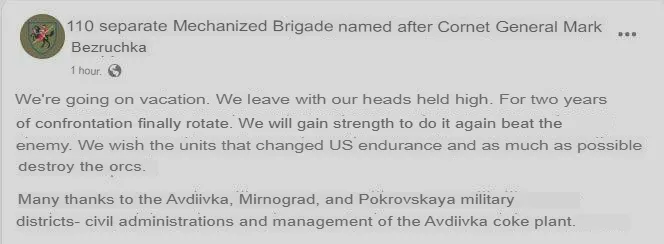
The writing is on the wall—even Ukrainian officials see what is obvious, that a domino effect may soon precipitate, with many areas falling one after the other: (Video at link.)
So, what is the big concern in the Avdeevka axis in particular, besides the lack of constructed defenses? Here’s one view from a Russian military analyst:
Yevgeny Krutikov: "Behind the new line of defence of the Armed Forces of Ukraine, which has developed in the Avdeyevka area at the moment (provisionally around Orlovka), an empty space has opened up in which there are no natural obstacles capable of supporting new defensive fortifications."
Yevgeny Krutikov: "There is nothing like this up to the next major settlements of the Donbass, primarily Krasnoarmeysk (Pokrovsky). The enemy has not strengthened the small villages there in any way, thinking it wouldn’t be necessary."
What he’s saying is, behind Orlovka, which Russian forces were said to have taken today, there are no good, naturally defensible positions all the way up to Pokrovsk. And this happens to be precisely where all the current talk revolves around.
For reference, here’s the current defense line which is a temporary transit point that Ukraine has already mostly lost:

But the Vovcha River is the central focus of the commentariat presently, as being the first truly defensible position Ukraine can reliably fall back to in the medium term—a point Big Serge underscores:
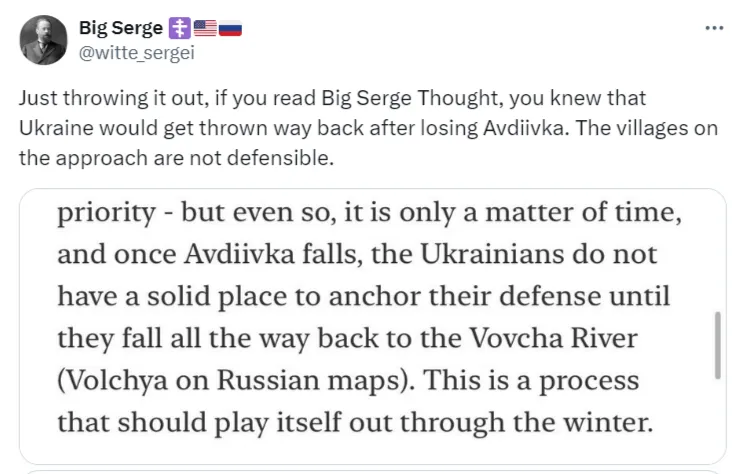
The natural defensive barrier of the river shown in yellow below:
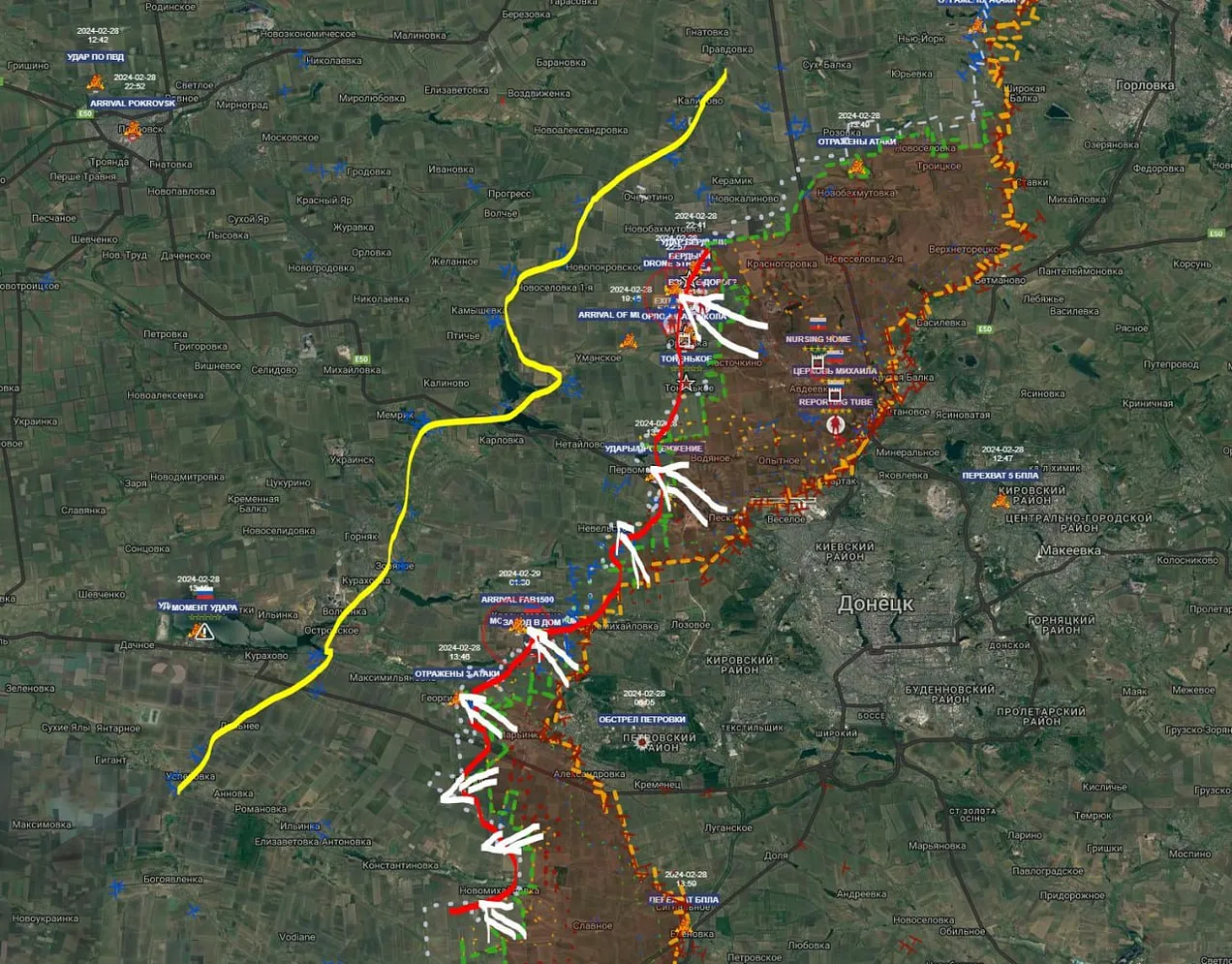
One Russian military linked channel says the river will be reached by end of March:
Two small boilers were formed near Avdiivka-between three settlements: Tonenke-Orlovka-Berdychy. They record conversations between military personnel, equipment and personnel. These "dead men" should slow down the advance of the Russian army, which is expected to reach the watershed of the Volchya River by the end of March. The next frontier for our infantry will be the Umanskaya-Novoselovka line to the west. The enemy will not have time to dig in well there and will not hold these villages.[/img]
And a Ukrainian take:
from Ukrainian channel
evening 02/28/2024
[The cascade of reservoirs should contribute to our defense in the Avdeevsky direction, - press secretary of the AFU Tavria OSUV (Group) Likhovoy]
PS
The APU will withdraw (while preserving HP as much as possible) beyond the Karlovskoye Reservoir and a chain of reservoirs, floodplains and streams along the vector to Ocheretino.
While the Armed Forces of Ukraine are fighting for the villages of Pervomaiskoye and Netailovo, their rear forces will be building new lines of defense behind the Karlovsky water chron at a frantic pace.
(our videoconferencing and high-precision technology will help them). Because the dam explosion will be blamed on our FABs in any case.
It is possible that several dams in the adjacent ponds and the Charles Dam itself will be blown up during our offensive.
This is further supported by Rezident UA channel:
Our source in the General Staff said that Syrsky gave the team to prepare Selidovo for defense and the creation of a fortified area from the city, while Pokrovsk, which now brings technology and BC, should become the main center of resistance.
The command has already transferred more than ten thousand military personnel to that area, who occupy empty houses and apartments, to create defensive structures.
Not to mention the following:
MI-6 handed over new intelligence to the Office of the President and the General Staff, which contains information on the preparation by the Russian army of four new strike corps for the spring offensive in eastern Ukraine. British intelligence believes that the Kremlin wants to collapse the front and seize new territories in order to strengthen its position in a protracted war.
—
As a final note:
Here’s a very evocative video of Orlovka, just to the west of Lastochkino in Avdeevka: (Video at link.)
Most striking are the gigantic Fab-500 craters, which are distinct from the regular 152mm shell craters moonscaping the surroundings. Julian Roepcke once more grieved at the sight of it, describing how Ukrainian positions were annihilated by the endless waves of Russian glide bombs, and how they stand no chance because of it:
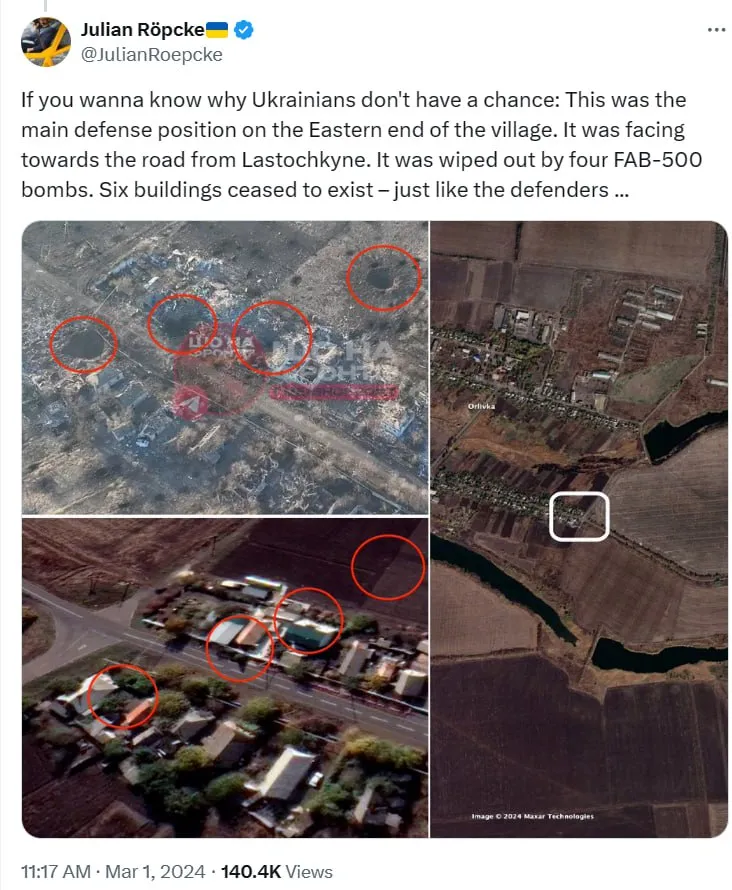
He further elucidates the situation:
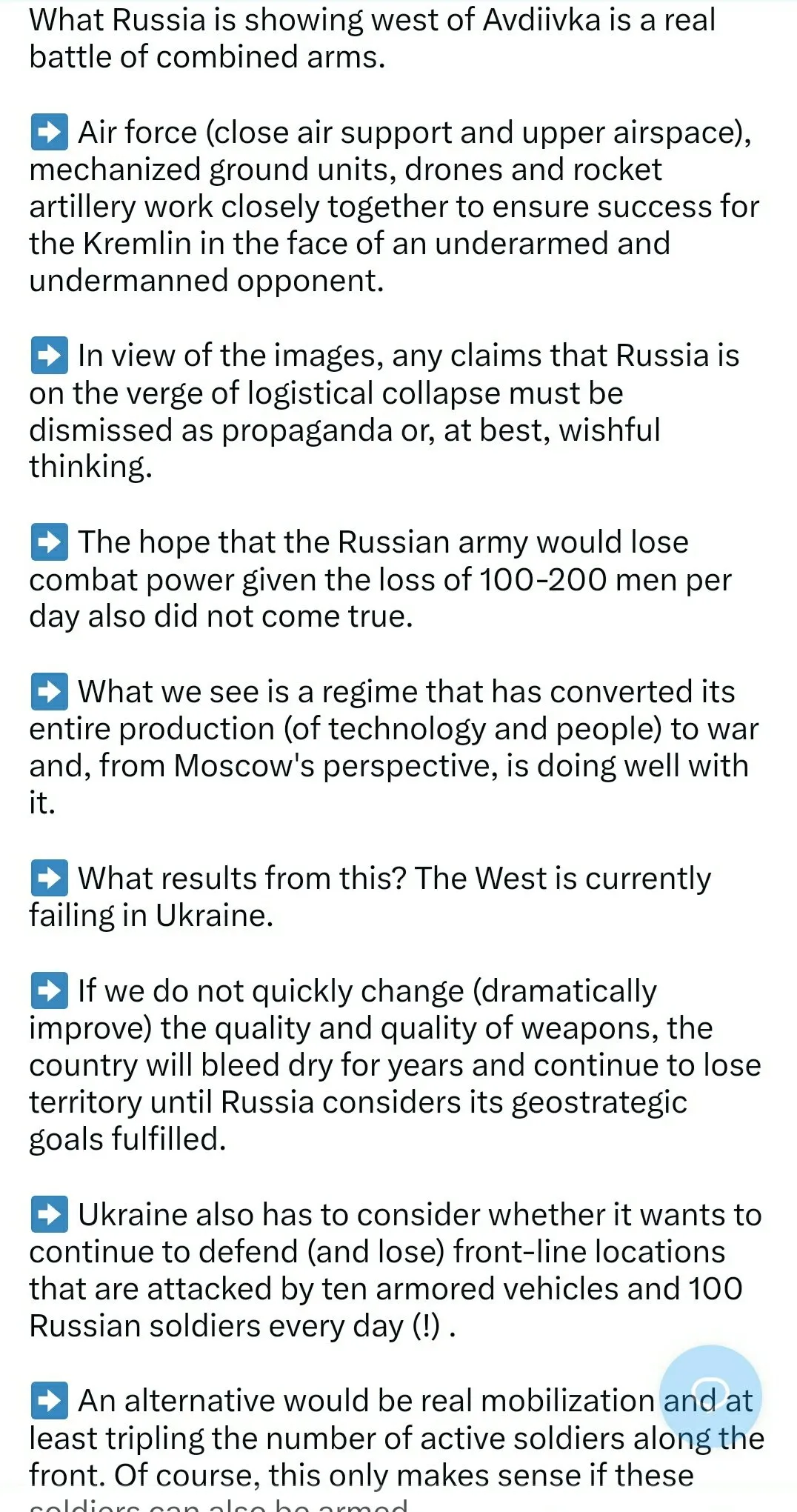
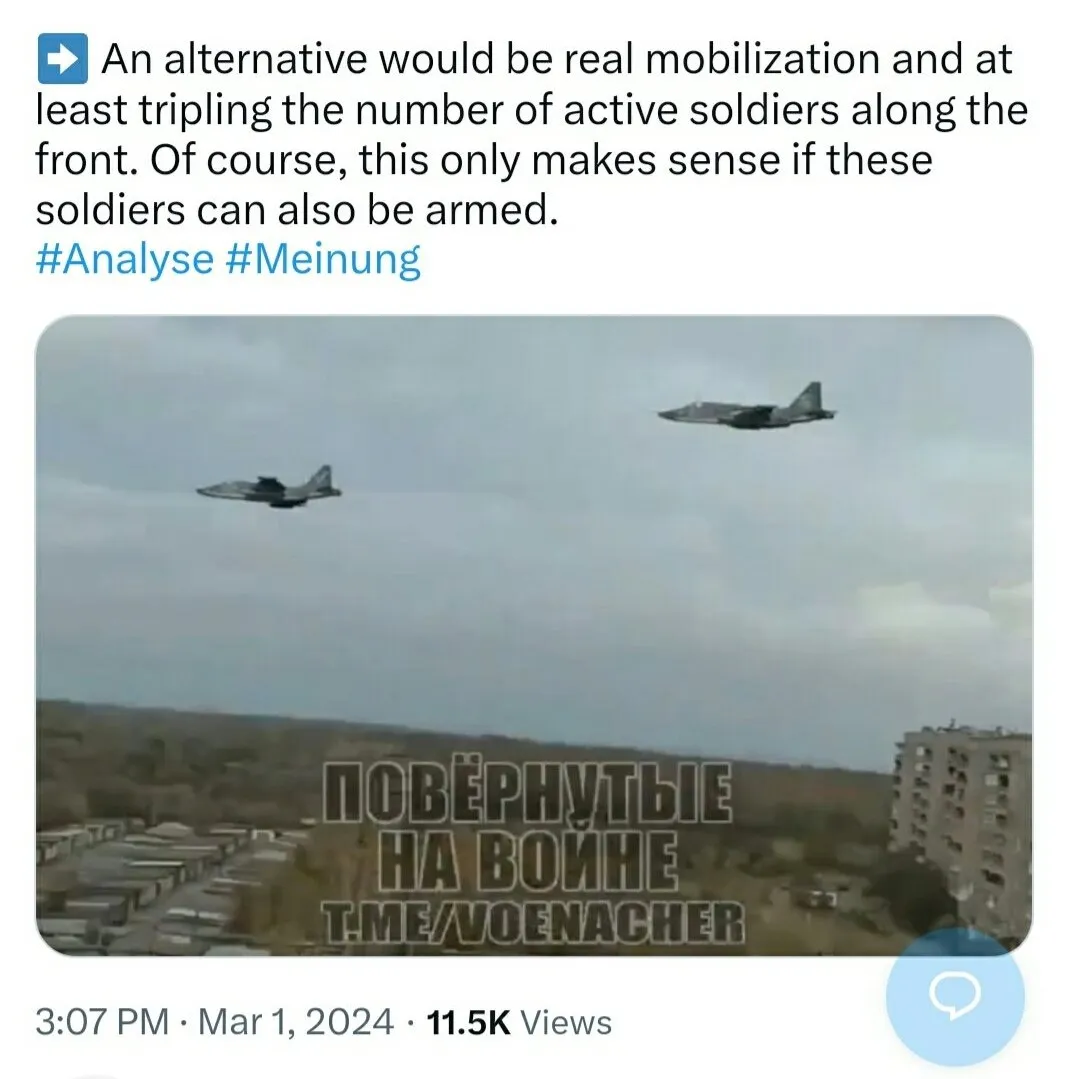
Lastly:
This quite astute observation from an ex-chairman of the NATO military committee, Harald Kujat, regarding the fallacy of ‘wunderwaffen’—like the Taurus missiles—saving Ukraine in any way: (Video at link.)
The opinion that Western arms supplies will turn the strategic situation at the front in Kiev’s favor is a fallacy. The ex-chairman of the NATO military committee, Harald Kujat, speaks about this. He also reminded the audience that “there were negotiations in Istanbul with an excellent result for Ukraine.”
“All the dead Ukrainians, as well as all the dead or wounded Russians after April 9, are due to the fact that Ukraine was not allowed to sign this peace treaty,” says Kujat.
https://simplicius76.substack.com/p/bun ... ell-german
(Much more at link, check him out.)
******
The Russian army is successfully Sovietizing, weak Ukrainian defense lines, fears of May
A look at military analysis and prognoses by Ukrainian experts
EVENTS IN UKRAINE
MAR 2, 2024
The Ukrainian media space has been quite gloomy of late.
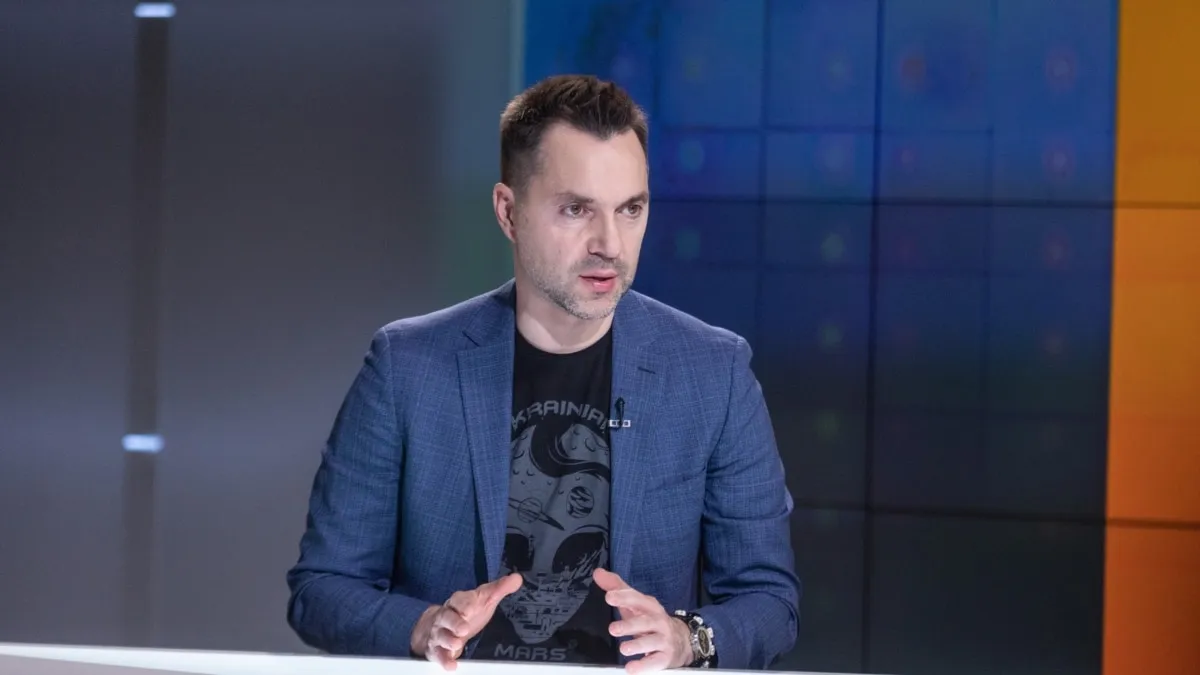
On February 29, former advisor to the President’s Office and self-styled military expert Alexey Arestovich gave an interesting analysis of the changing organizational structures of the two armies on the frontline. Analyzing the reasons for the loss of Avdiivka and the ongoing retreat there, he writes that Russia appears to be successfully transitioning to the organizational structure of the Soviet army:
“Avdiivka was stormed by three Russian armies + a tank division. These are units with unchanging personnel, with unified logistics and a management system. For us, in contrast, everything above a brigade is an assembled body that can be managed from elsewhere.
We saw elements of operational camouflage in the creation of a group/concentration of forces. Deception, cunning, disinformation - in the best traditions of the Red Army.
Massing of forces. The Russians are enhancing the artillery capabilities of their units and formations - up to the creation of artillery brigades within an army of combined arms units.
The number of guided aerial bombs used is increasing every month. In the defense area of Avdiivka, in one day, there were 250 hits.
The irretrievable losses of the Russian grouping in taking Avdiivka are ~30% of the grouping. Yet, they captured the fortified district. Soviet standards - 12-20% for an army operation.
Avdiivka is their first operational-tactical level success, associated with the drift towards the Soviet system. The deadlock on the front, which Valeriy Zaluzhny talked about in the article for "The Economist," was overcome not by technical means, but by organizational ones.
When they fully transition to the Soviet system - we can expect them to start achieving operational level successes, as it is ideal for this type of war - given their initial conditions.
For them, to make us lose all of the Left Bank [everything east of Kiev and the Dniepr river], they need about five such operations.
They are increasing capabilities and reducing the intervals between operations. A year ago they took up to six months for concentration of efforts and preparation. This will be reduced to four months or less, if there are no strategic scale black swans (planning should be based on the assumption that there won't be any).
Not only I have been saying from the start of the war that Russia's problem in this war is that they set Soviet goals without having Soviet capabilities. And now they are gradually pulling their capabilities up to Soviet levels, as much as possible.
All our (and theirs, by the way) dreams about Western structures, Western technology, and Western strategy - are complete nonsense. We currently have neither Soviet capabilities nor Western ones, and they are catching up to the Soviet ones.
What's our response?
Valeriy Zaluzhny was not allowed to form divisions and armies - units and formations of permanent composition, with their own logistics and permanent management bodies, capable of solving the task of breaking through long-term, echeloned defense of the enemy and creating/maintaining such defense.
It's against NATO standards!..
Idiots, instead of creating a national military school, tailored to our specific conditions, choosing the best from different systems, are killing the army under a concept that:
we will never see,
which is not suitable for large-scale wars on its own.
Soon we will fully experience these "…NATO standards". There are no fortifications at Chasov Yar, was it too much trouble to dig, it wasn’t standard? What about after Avdiivka - no? Kramatorsk?", writes Arestovich.
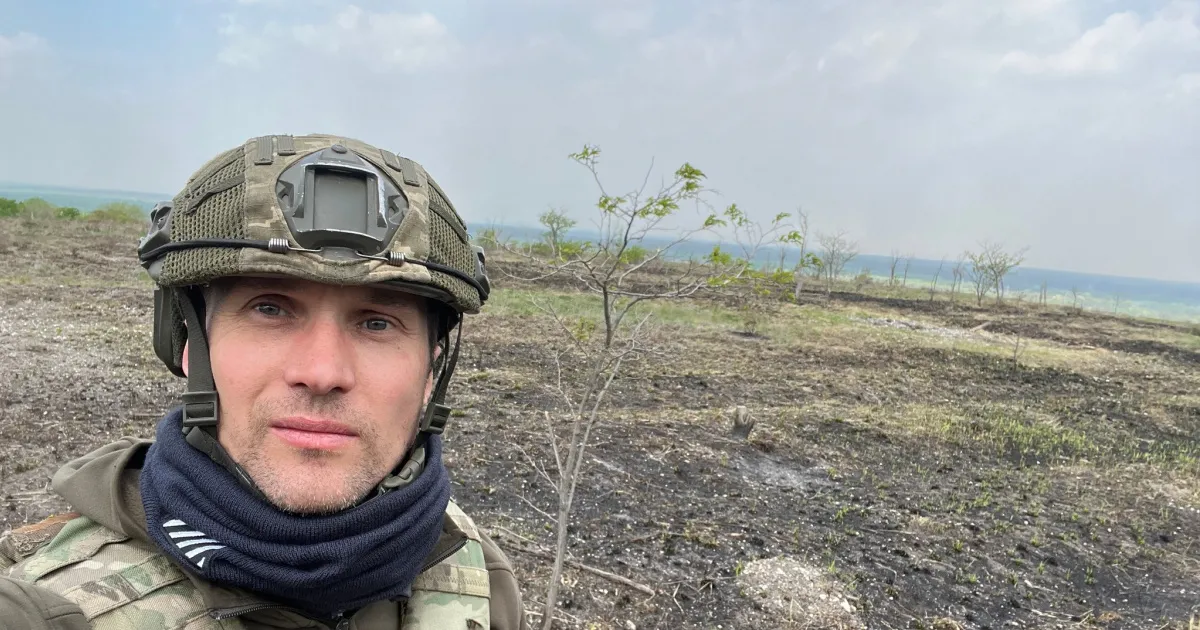
Yury Butusov, a Poroshenko aligned hyper-nationalist military journalist, also made worrying prognoses on Feb 27:
"No words. There's a disconnect: here in Kyiv, the Supreme Commander says one thing, but on the front line, something completely different is happening. I want to say: no field fortification lines have been built behind Avdiivka so far. I saw how our soldiers, in holes in the middle of a field, are attacked by Russian drones," said Butusov.
According to him, serious problems exist which cannot be overcome by the government’s constant appeal to intensify mobilization of human resources:
"If the authorities cannot find builders to construct at least basic rear defense lines, if they cannot find engineers to service modern technology, drones, sensors, communications, if they cannot find workers and technologists to produce ammunition, then there will never be enough assault troops," the journalist added.
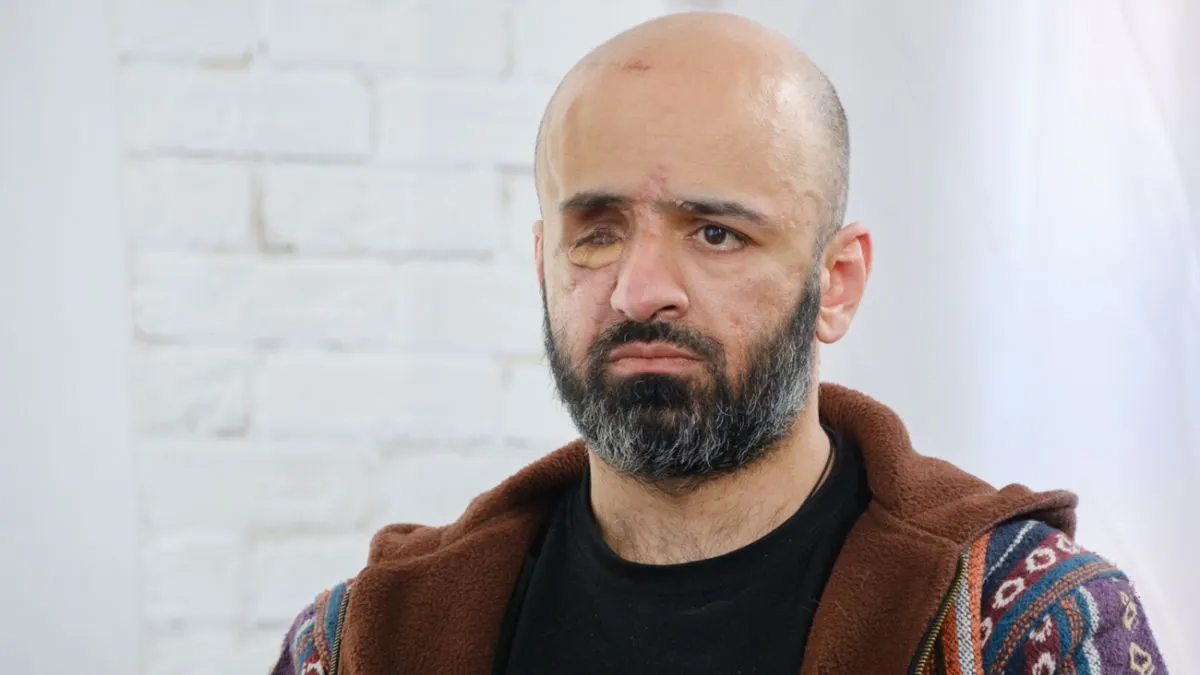
Others combined their pessimism with a demand to mobilize more Ukrainians. Masi Naiem is part of a venerable family of Ukrainian euro-optimists, his brother, Mustafa Naiem, being the famous journalist that began the Euromaidan protests back on the 21st of November, 2013 (he subsequently became a not-very-successful board member of the state military industrial company). His brother, Masi, lost his eye while fighting the Russian army. In a 26 February interview, he claimed that Ukraine is likely to lose its statehood, especially if mobilization is not intensified, even of those who are ‘not motivated’ to fight.
"People [who worry about mobilization impeding their work-life balance] need to understand something very important. This is not a distant probability. These threats are so real that, figuratively speaking, the month of May does not seem Ukrainian to me, and, if certain things do not happen now, it is quite likely that by May you will need to plan to live in another country, if you are a patriot, because you will not be able to live here under the Russians. Now you can shove that 'motivation' and go live in Poland with those idiots who are now dumping grain. You now have to choose your motivation: either you take action yourself and defend this state, or go to the Poles."
May has particular significance - Zelensky’s presidential term will run out at that time, and lately he has been ringing the alarm about supposed ‘Russian plots to discredit our government’ through the use of this fact. Hopefully an upcoming rundown of recent news will go into that.
https://eventsinukraine.substack.com/p/ ... ccessfully
*******
Analyzing The Leaked Bundeswehr Recording About Bombing The Crimean Bridge
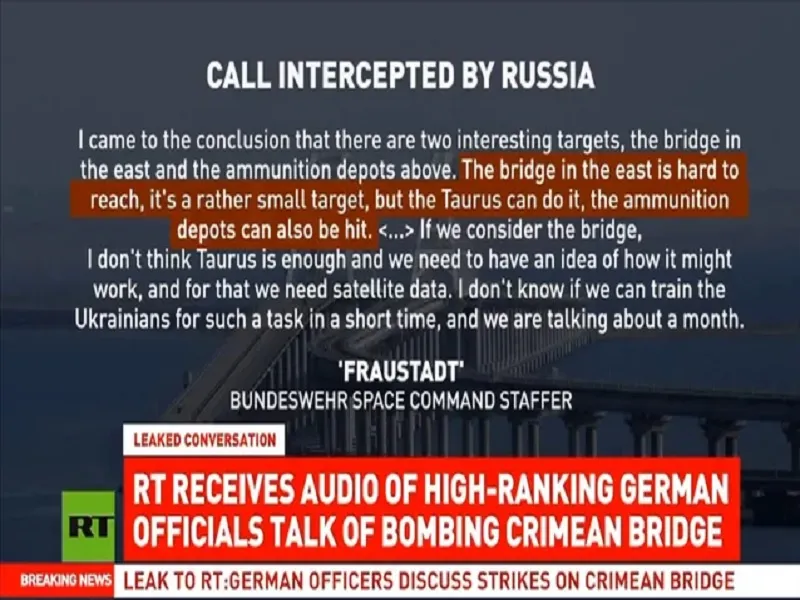
ANDREW KORYBKO
MAR 2, 2024
The takeaway from this scandal is that elite elements within the Bundeswehr are serious about further embroiling their country in the Ukrainian Conflict despite the increasing risk of the West’s undeclared but limited hot war with Russia spiraling into World War III by miscalculation.
RT editor-in-chief Margarita Simonyan was the first to report on Friday about Russia’s possession of a leaked Bundeswehr recording implicating the German Armed Forces in a plot to bomb the Crimean Bridge. The transcript and audio were subsequently released by Sputnik here. The German Defense Ministry then launched an investigation, after which national media cited sources to report that Berlin believes that the recording is indeed authentic and not an AI hoax.
It turns out that four Air Force personnel were involved in this scandalous conversation, two of whom are senior members such as the department head for operations and exercises and the Air Force Inspector, while the remaining two are employees at the Space Operations Center. They began by saying that they want to prepare for the possibility of Chancellor Olaf Scholz approving the shipment of long-range Taurus missiles to Ukraine and questioning why he’s thus far blocked these deliveries.
Speculation about them simply not working was acknowledged but downplayed, with the conversation then shifting to ways in which Ukraine could fire these missiles if they receive them. They also referenced the methods employed by the British and French to deliver similar arms, but then they concluded that it’ll be difficult to dispatch them right away. Speeding up the shipment, they warned, could lead to errors in their use like “hit[ting] a kindergarten, and there will be civilian casualties again.”
Nevertheless, one of them suggested sending batches of missiles at five each, but then they wondered who’d pay for this and related production details. Another issue is training the Ukrainians, which could allegedly take three to four months and occur in Germany. Someone also suggested that the British could help with technical issues related to mounts and whatnot given their experience with this. Another important point is retaining plausible deniability the whole time in order to avoid uncomfortable optics.
To the surprise of no astute observer, someone remarked that “there are numerous people [in Ukraine] in civilian attire who speak with an American accent”, thus indirectly confirming the presence of Americans inside the conflict zone who they said could help Ukrainians operate the Taurus missiles. Something else that was interesting about this conversation was one of these officials hinting that Germany feels pressured to follow France and the UK’s lead by sending its own long-range missiles too.
They then started talking about hitting the Crimean Bridge, perhaps after recalling the British Storm Shadows’ role in last summer’s attack, concluding that around 20 missiles might be needed to destroy it. The reason why they’re interested in targeting that piece of civilian infrastructure isn’t because of its military-strategic importance, which someone said is no longer as much as before due to the ground corridor that’s been established these past two years, but because of its political significance.
In the event that the “initial task” is only to hit ammo depots instead of the Crimean Bridge, someone noted, everything can proceed a lot faster. They also said that “The longer they take to make a decision, the longer it will take us to implement it. We need to break everything down into stages. Start with the simple first, and then move on to the complex. Or we can ask the British if they can support us at the initial stage, and have them take on the planning issues?”
Reflecting on these main points from mid-February’s secret recording that Berlin reportedly believes is authentic, it can be assessed that the initial reaction here about the Bundeswehr going behind Scholz’s back was accurate since they’re already making detailed plans without his approval. They also indirectly confirmed the presence of American, British, and French troops on Ukrainian soil, who are advising that country and directly helping it utilize their foreign-supplied arms against Russia.
What few observers have yet to draw attention to, however, is the remark about how “there might be an error in its use, the missile might hit a kindergarten, and there will be civilian casualties again” if the timeframe is sped up for delivering these missiles before the Ukrainians are ready to operate them. This could be interpreted as tacit admission that Ukraine not only hit civilian sites before on accident, but that this was partially the West’s fault for giving them arms that they weren’t properly trained to use.
It's not mentioned in the conversation, but the context suggests that the West’s solution was to dispatch troops there like Scholz strongly implied last week that France and the UK have already done in connection with their own long-range missile shipments to Ukraine to assist with “target control”. The Air Force officials involved in mid-February’s secret recording didn’t allude to any interest in following suit, but it can’t be ruled out that they might either be allowed to or decide to do this unilaterally.
After all, they spent a lot of time discussing how Ukraine could use their missiles as soon as possible if the decision is made to send them, so they could either convince Scholz to dispatch troops there like France and the UK already did for this purpose or go on their own and make this a fait accompli. The dual pretext for either scenario is to reduce the chance of civilian casualties and deal damage to Russia (including political with respect to the Crimean Bridge) sooner rather than later.
The takeaway from this scandal is that elite elements within the Bundeswehr are serious about further embroiling their country in the Ukrainian Conflict despite the increasing risk of the West’s undeclared but limited hot war with Russia spiraling into World War III by miscalculation. The real threat to Germany therefore isn’t the left and right working together like the Washington Post fearmongered last April, but these powerful military figures who have no compunction about flirting with the apocalypse.
https://korybko.substack.com/p/analyzin ... -recording
It would be no surprise if the US 'owned' half the generals on the planet.

